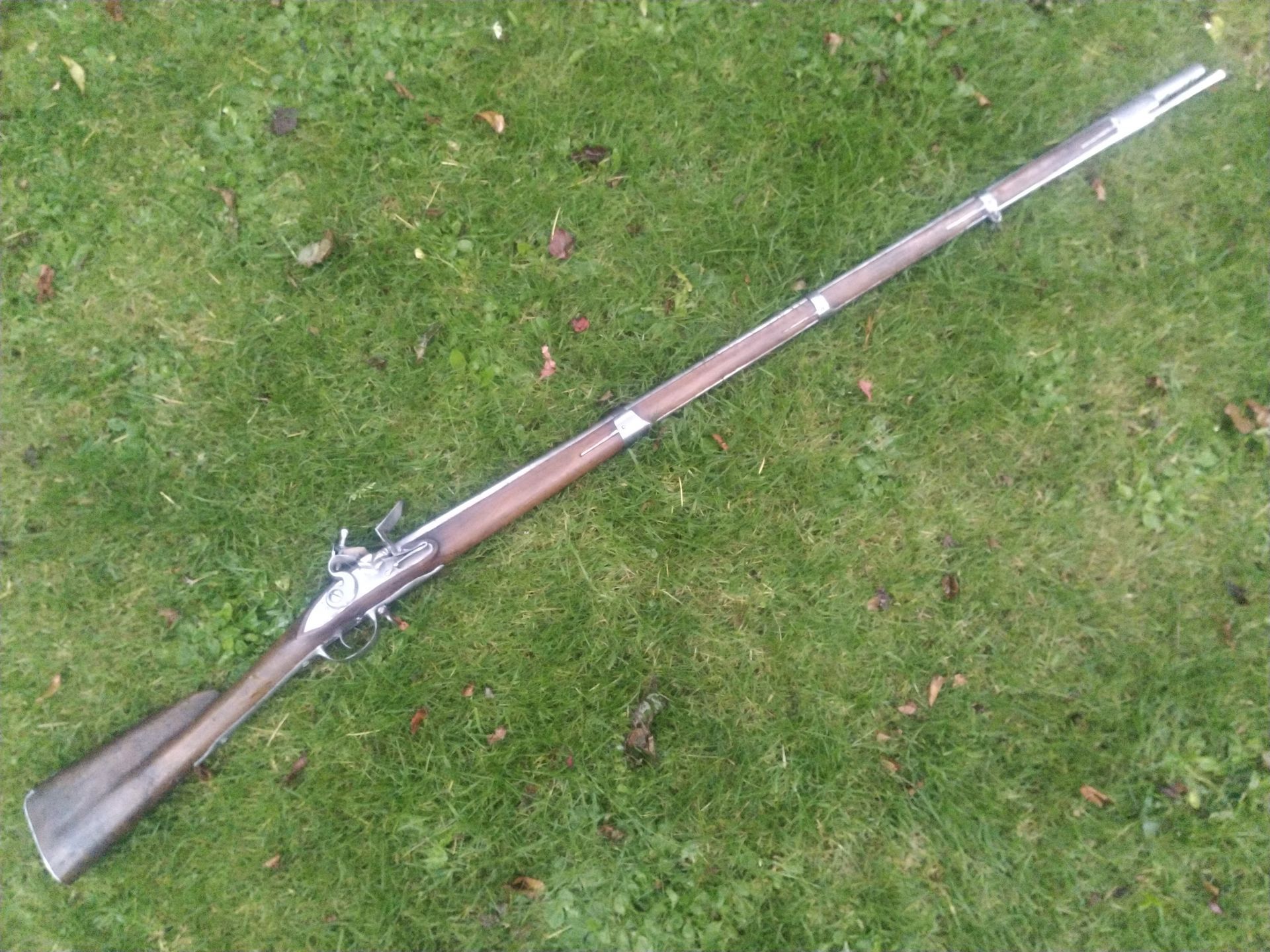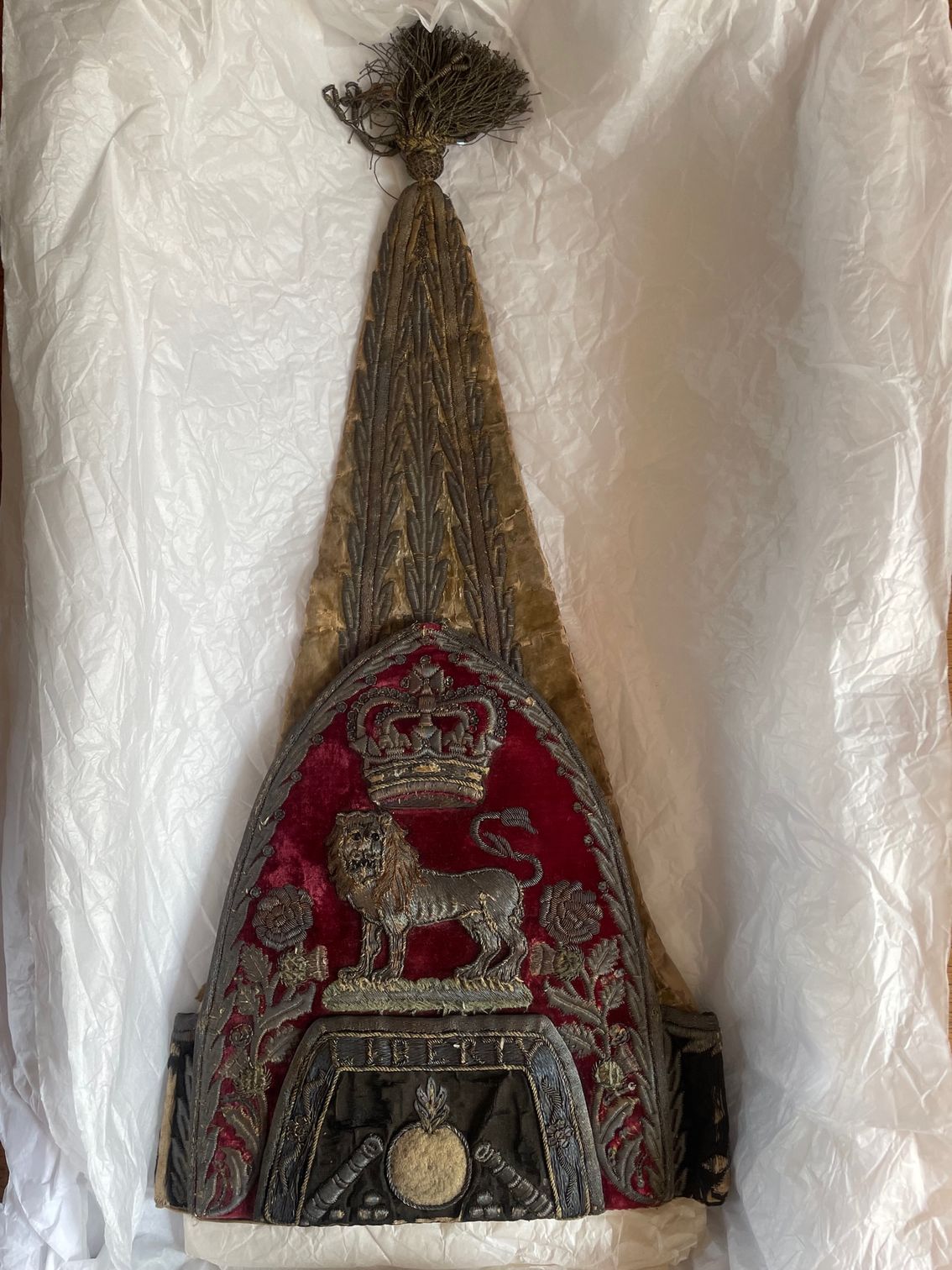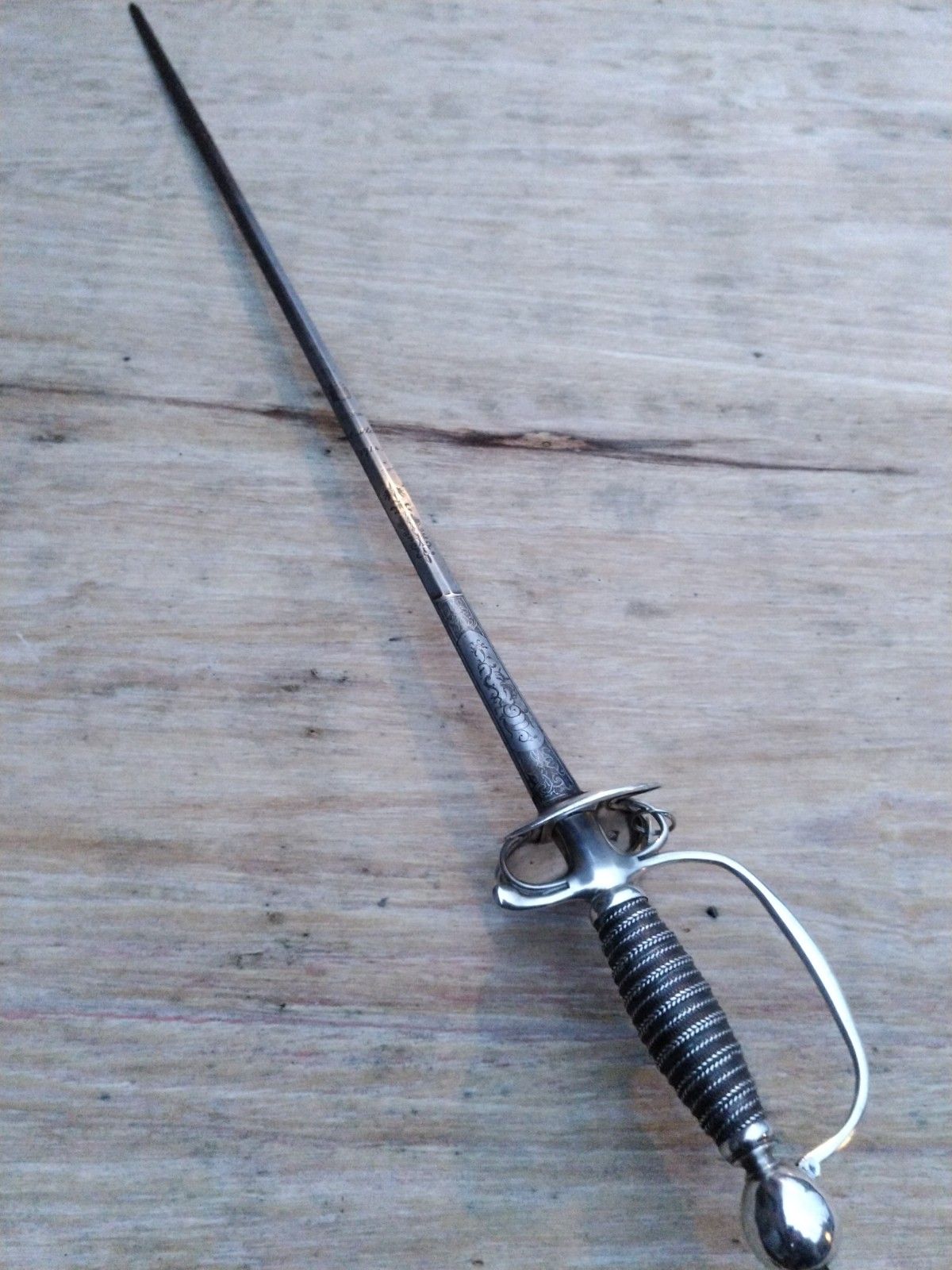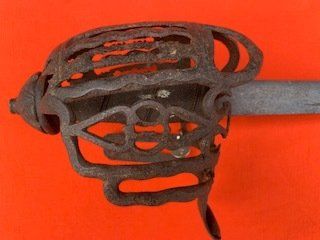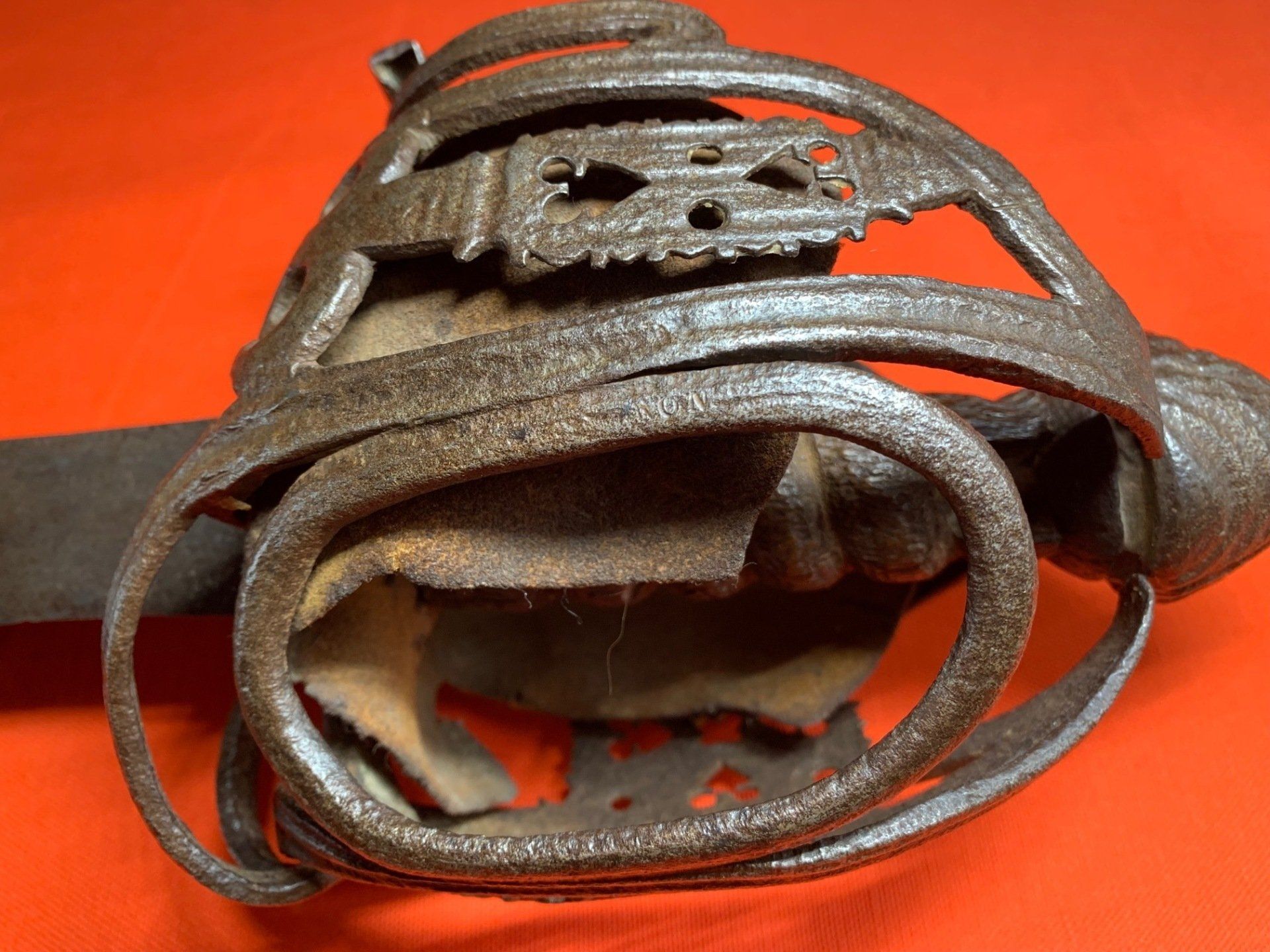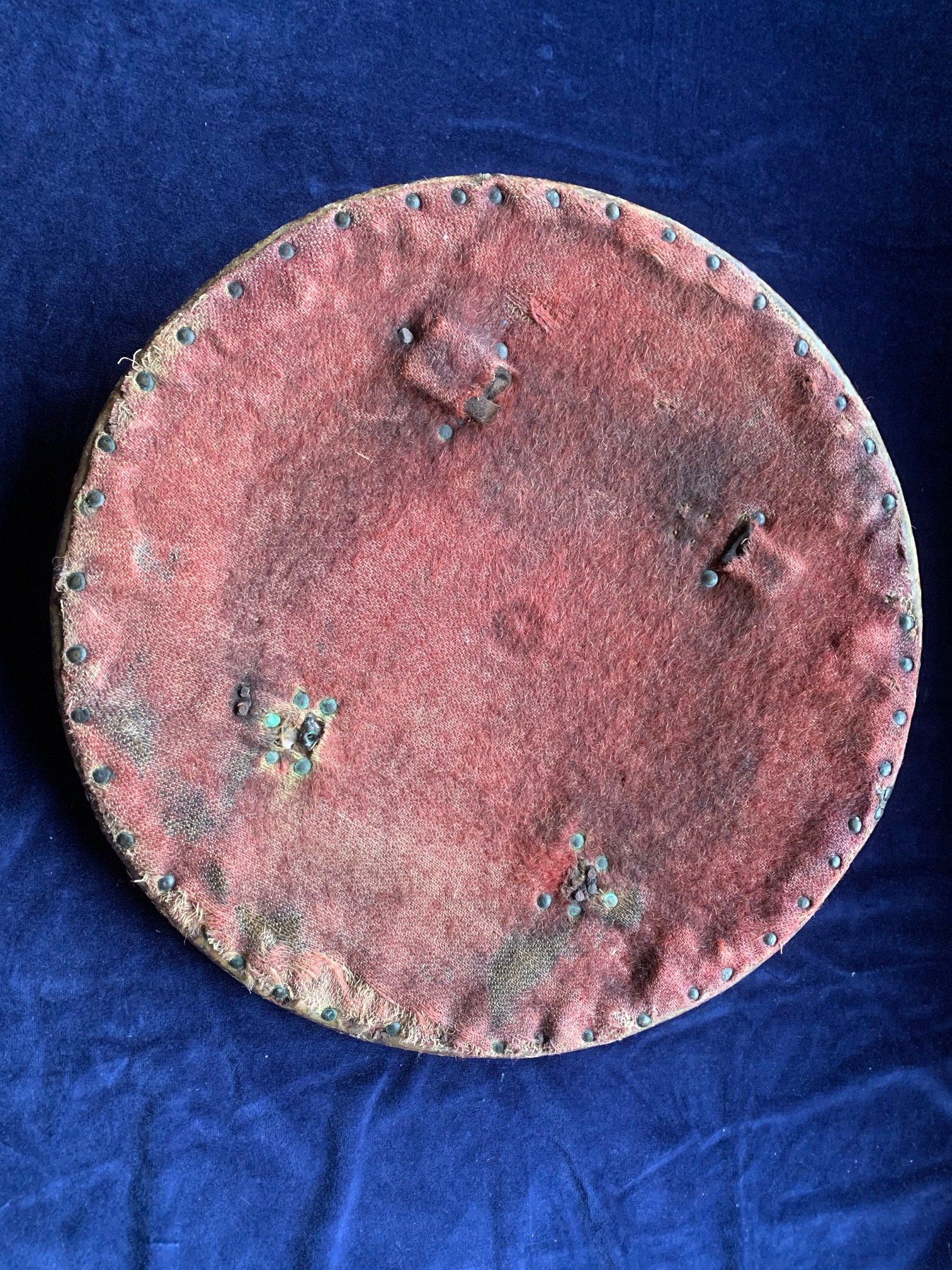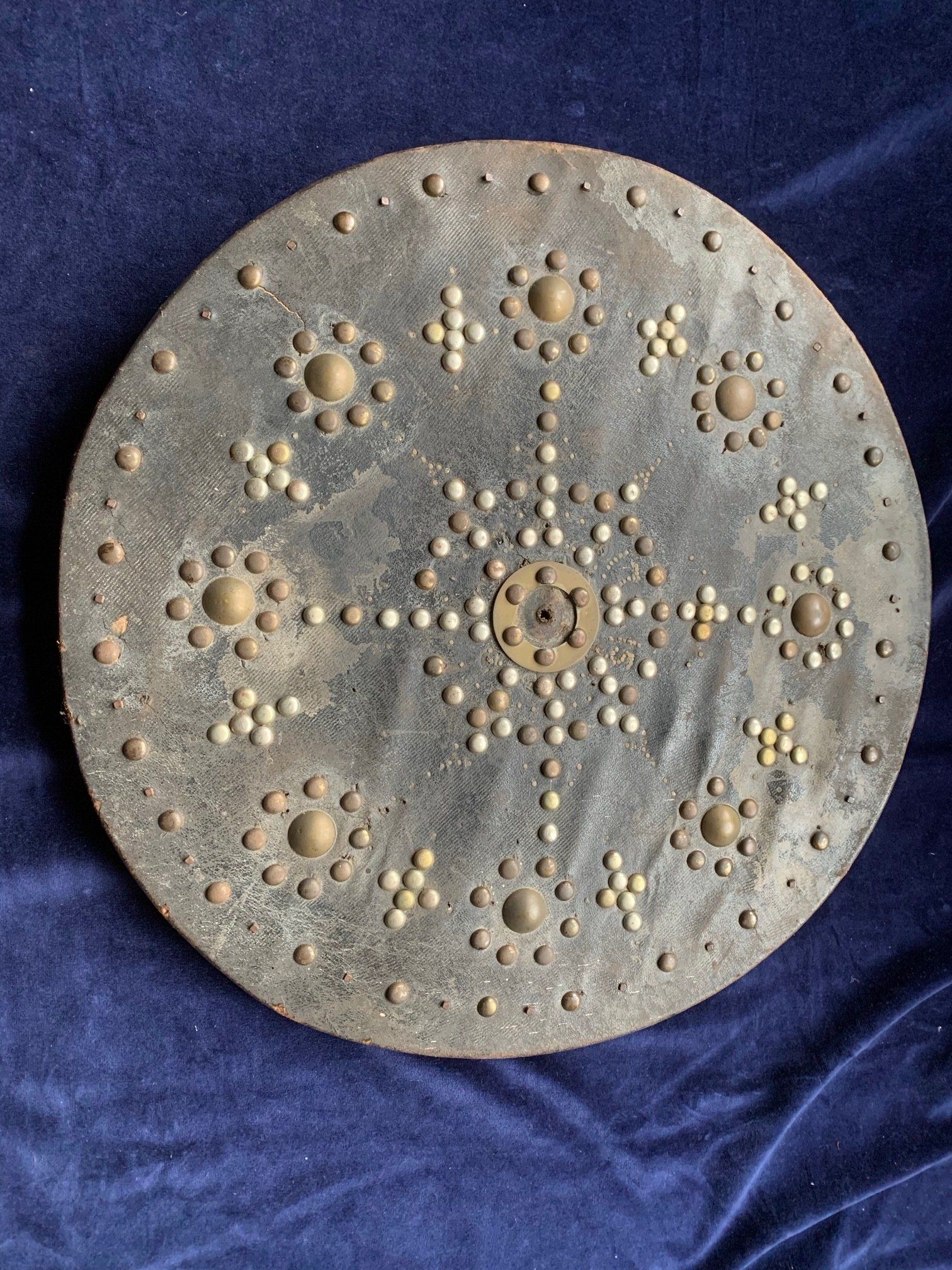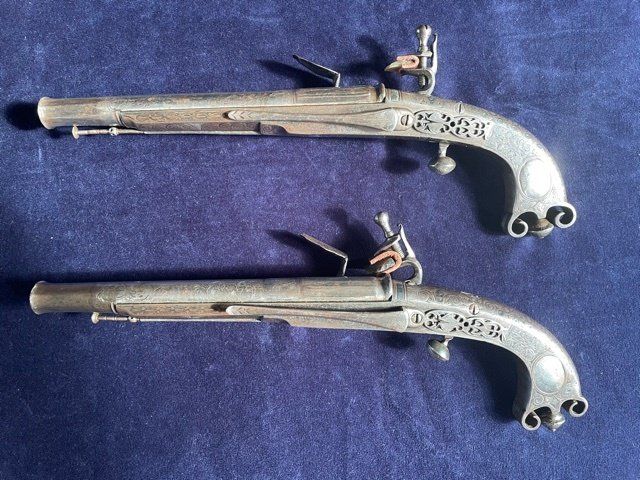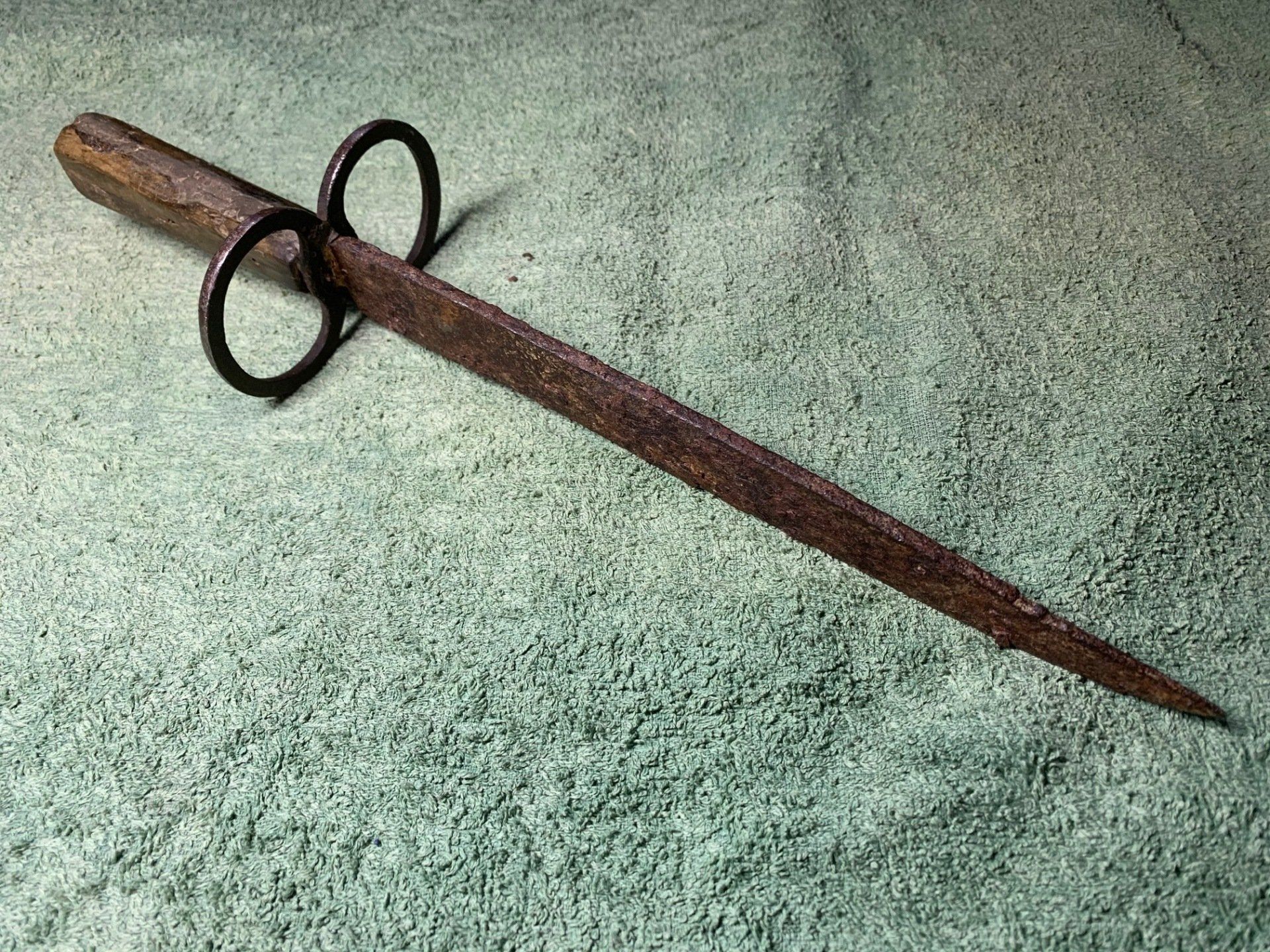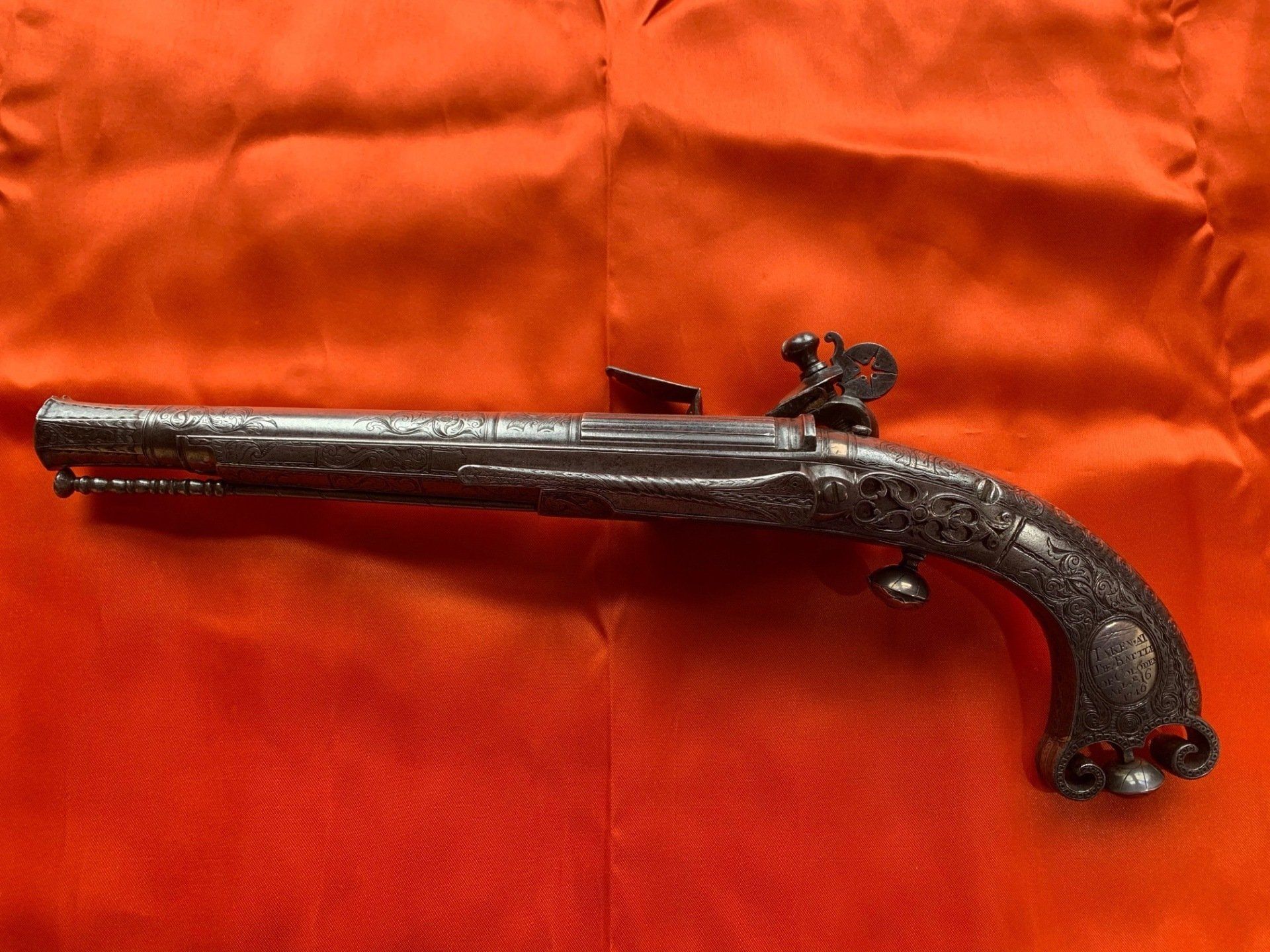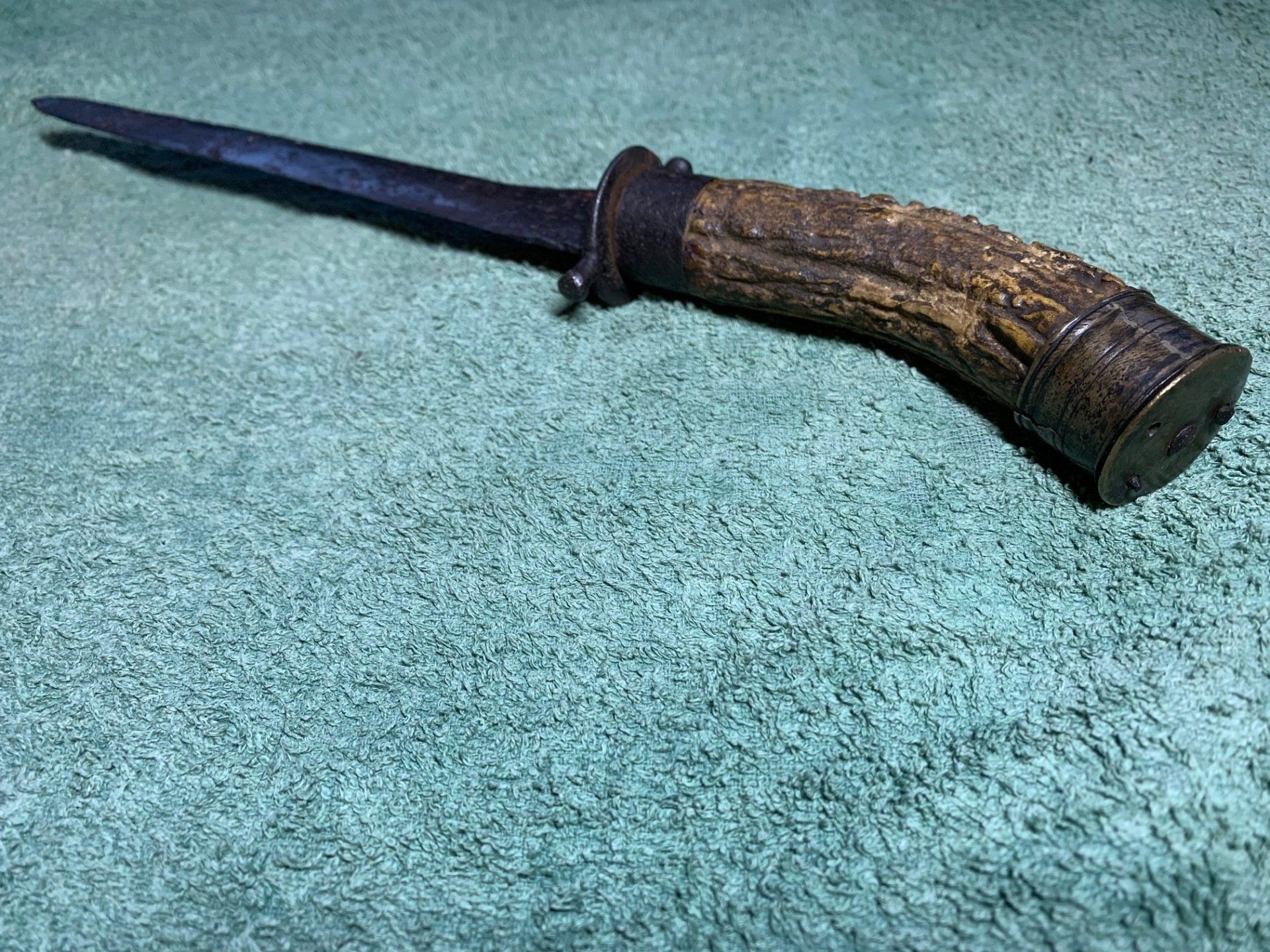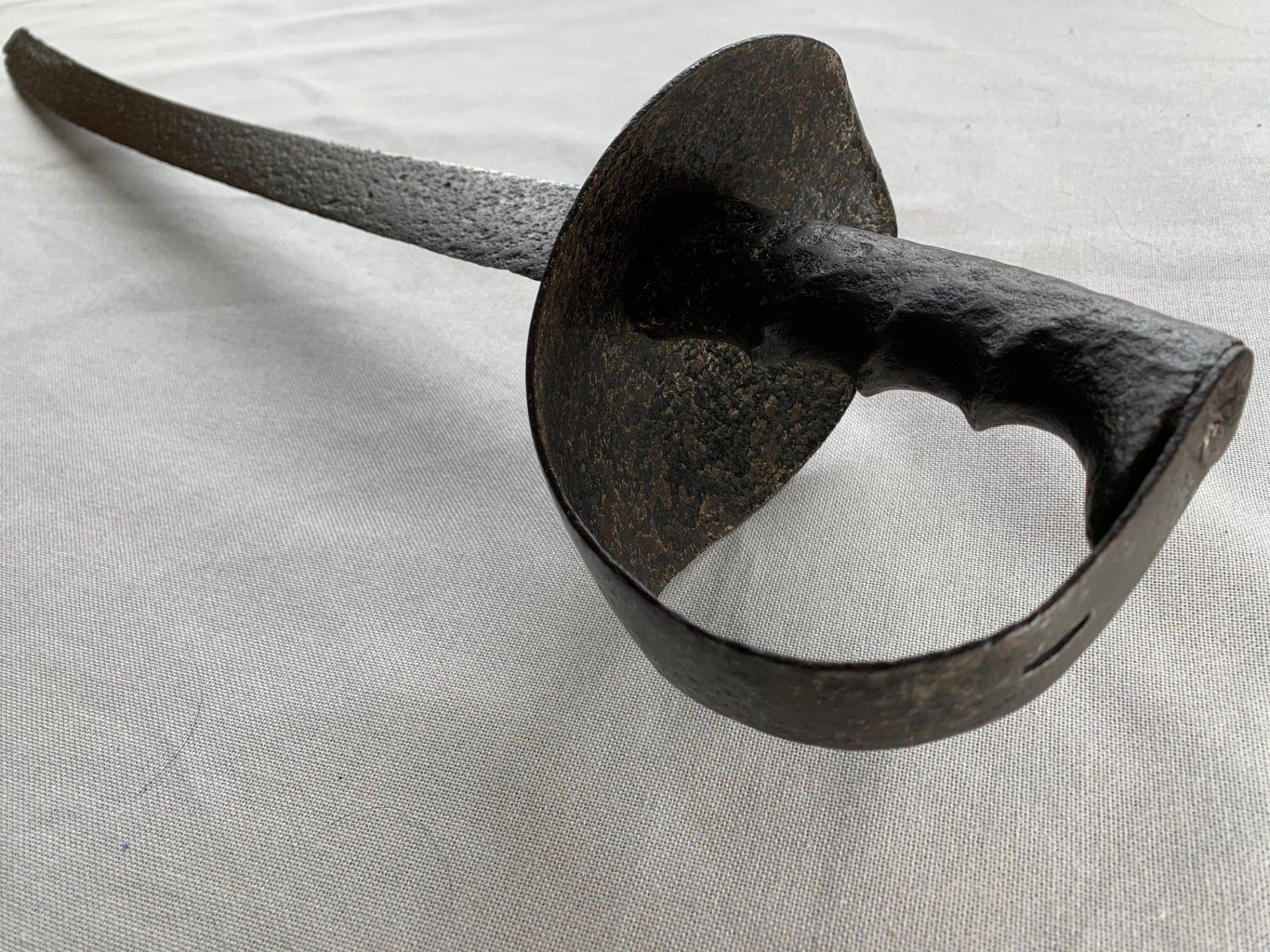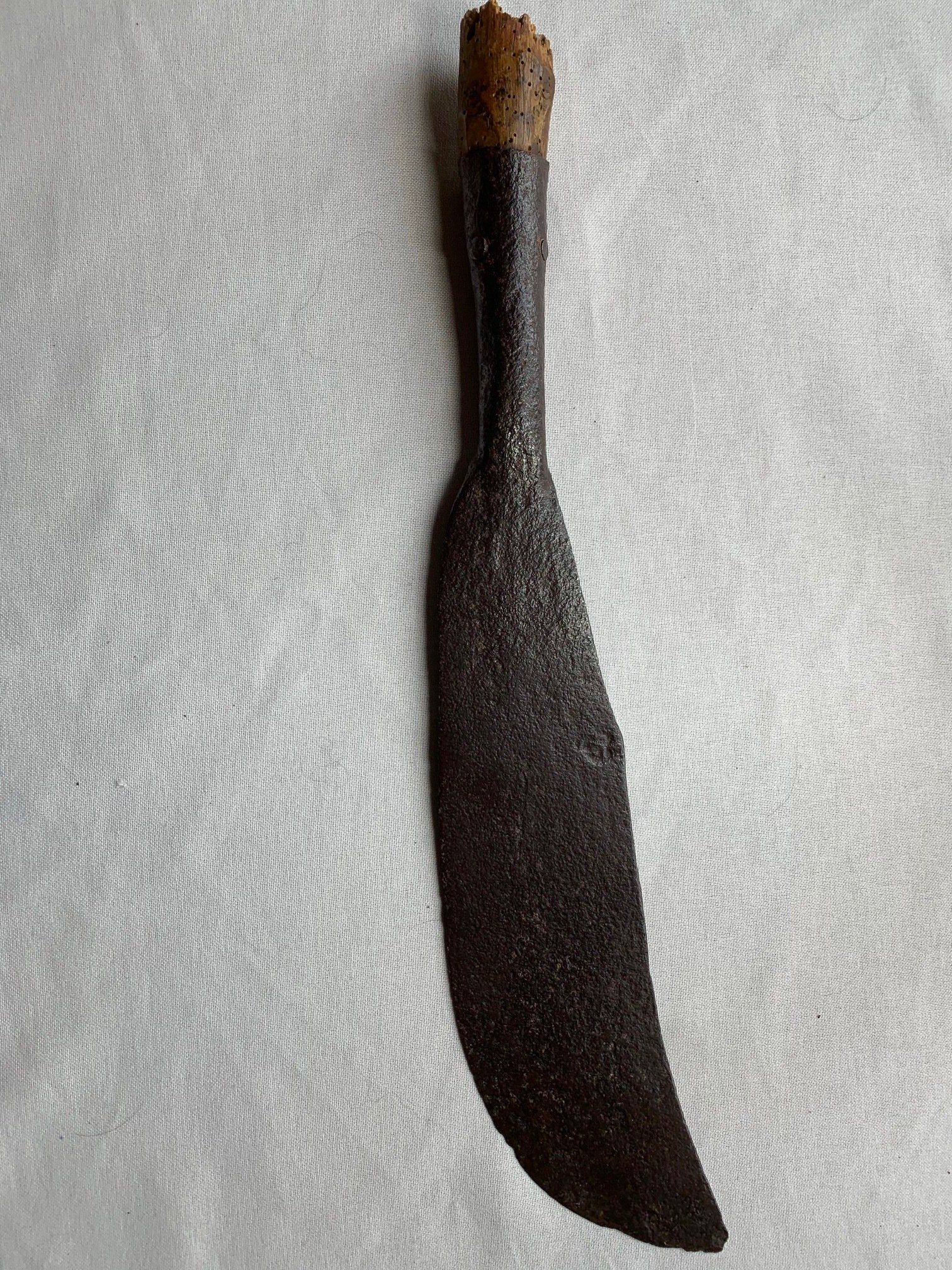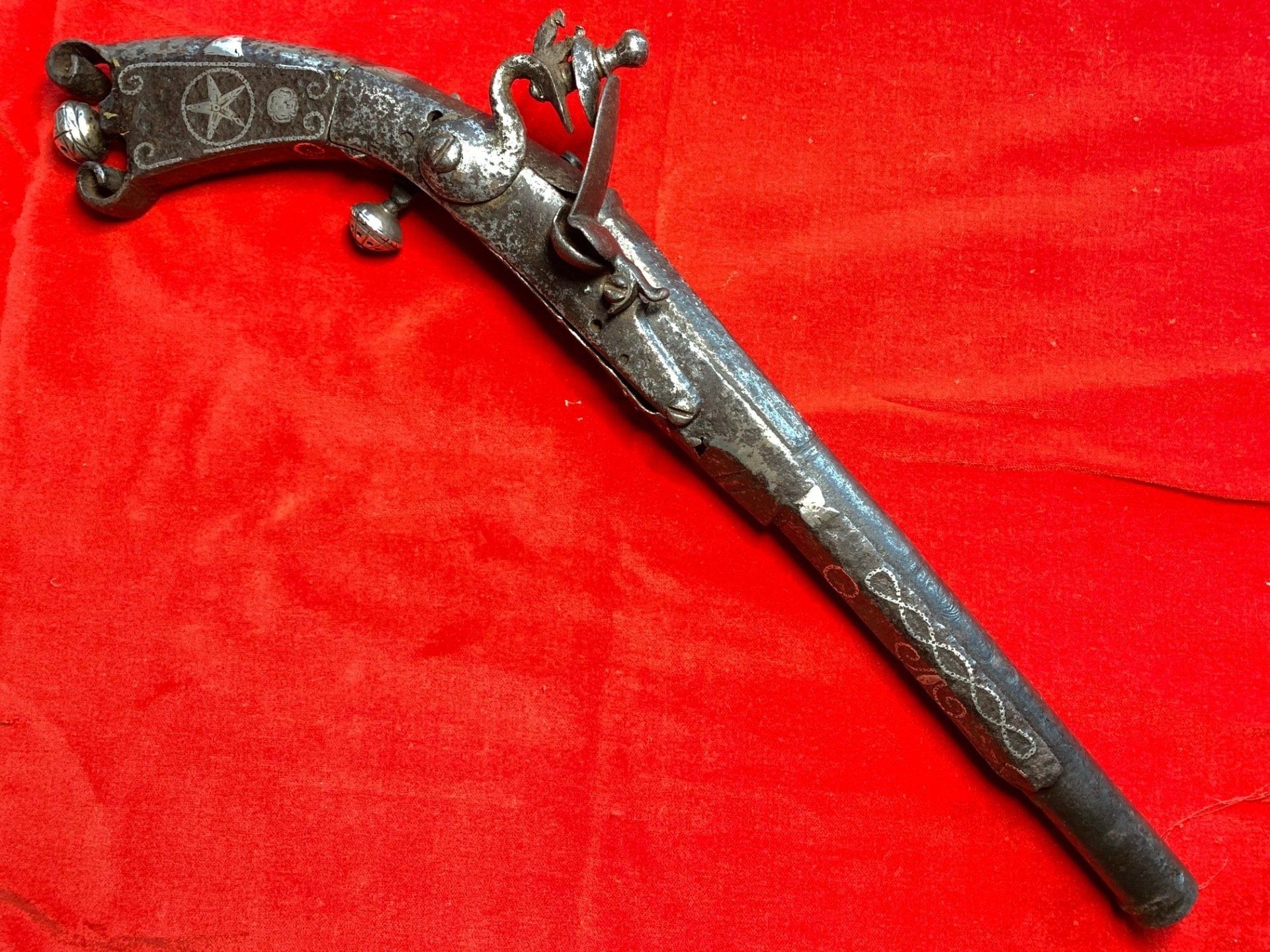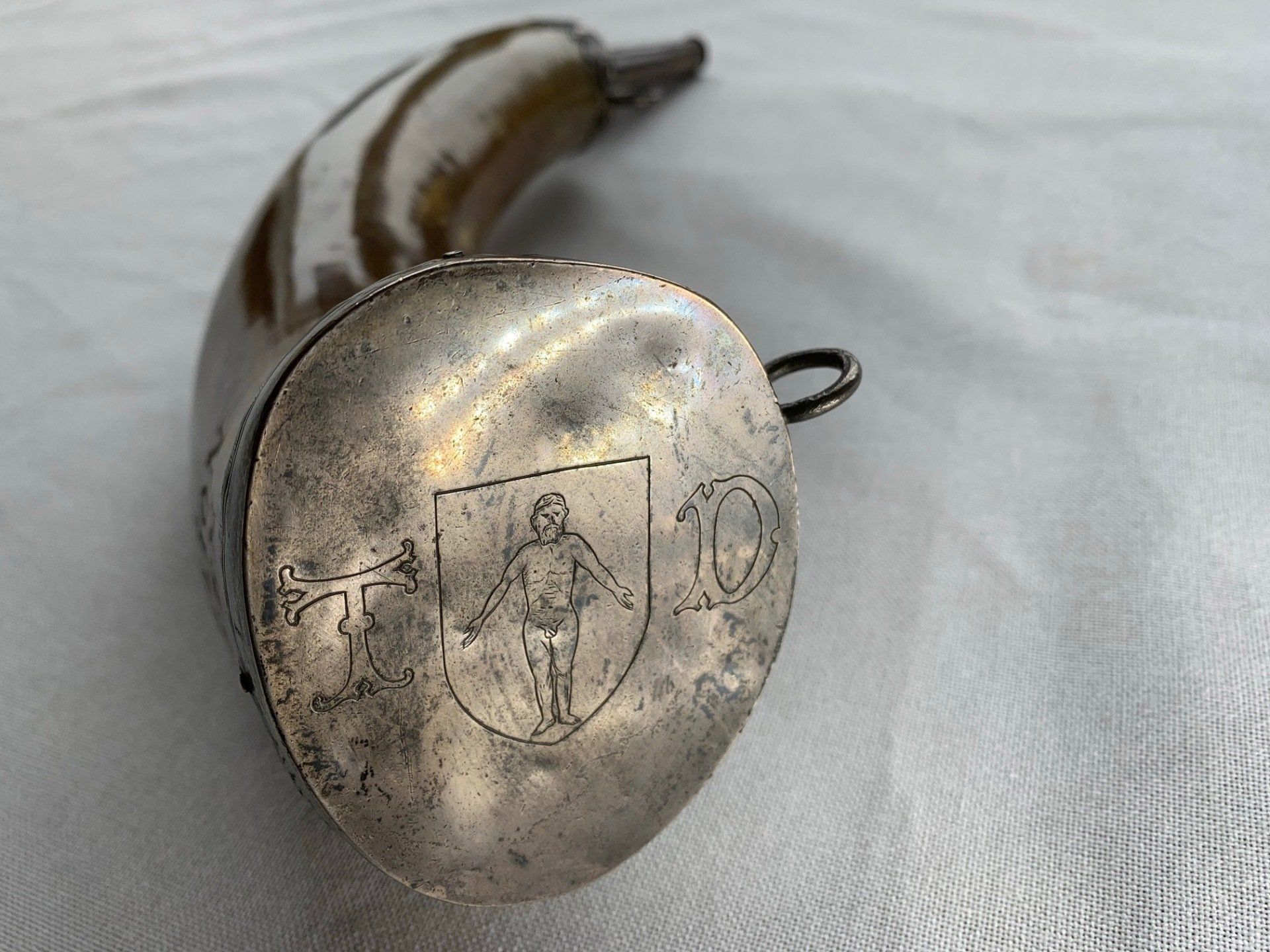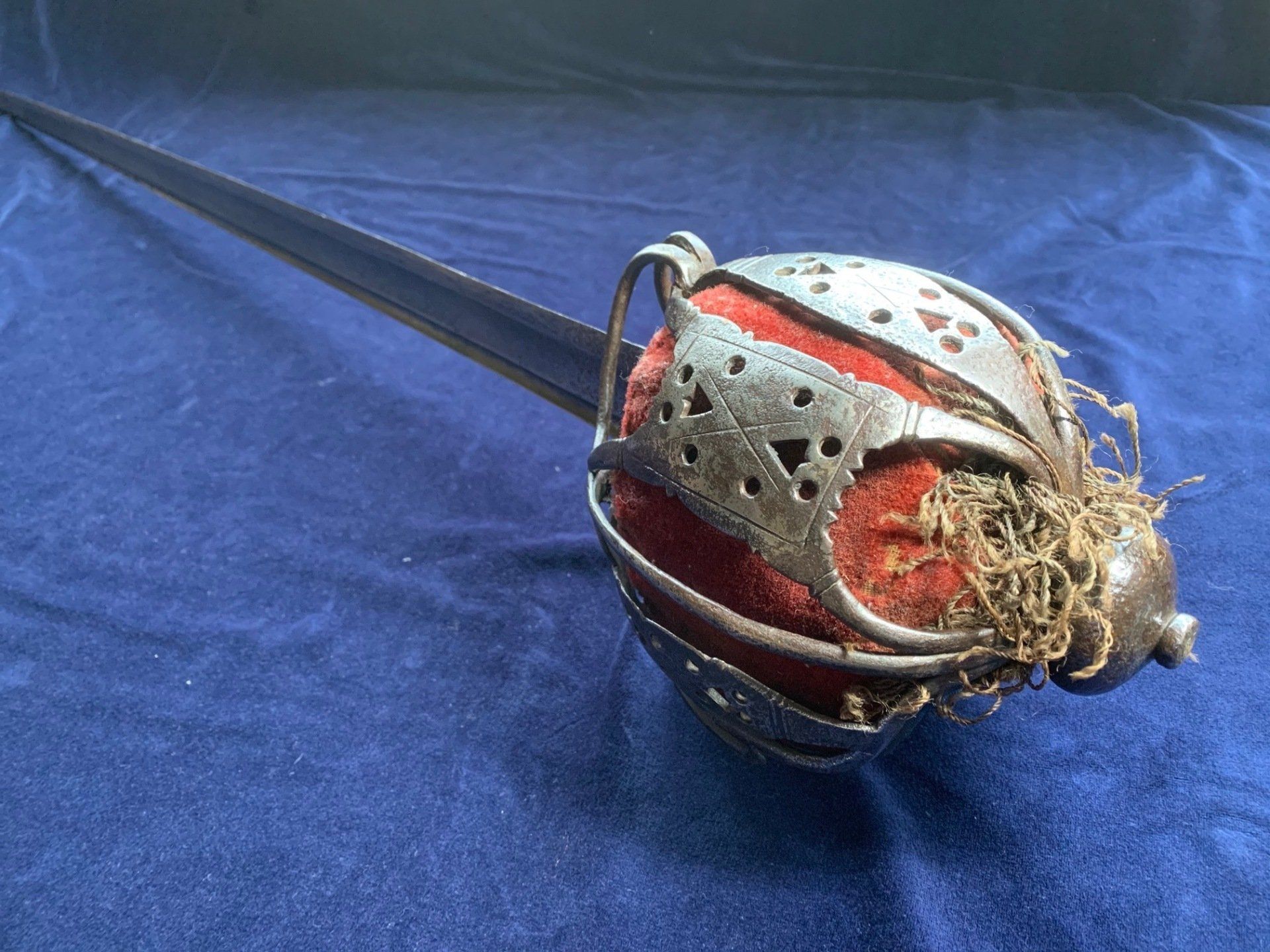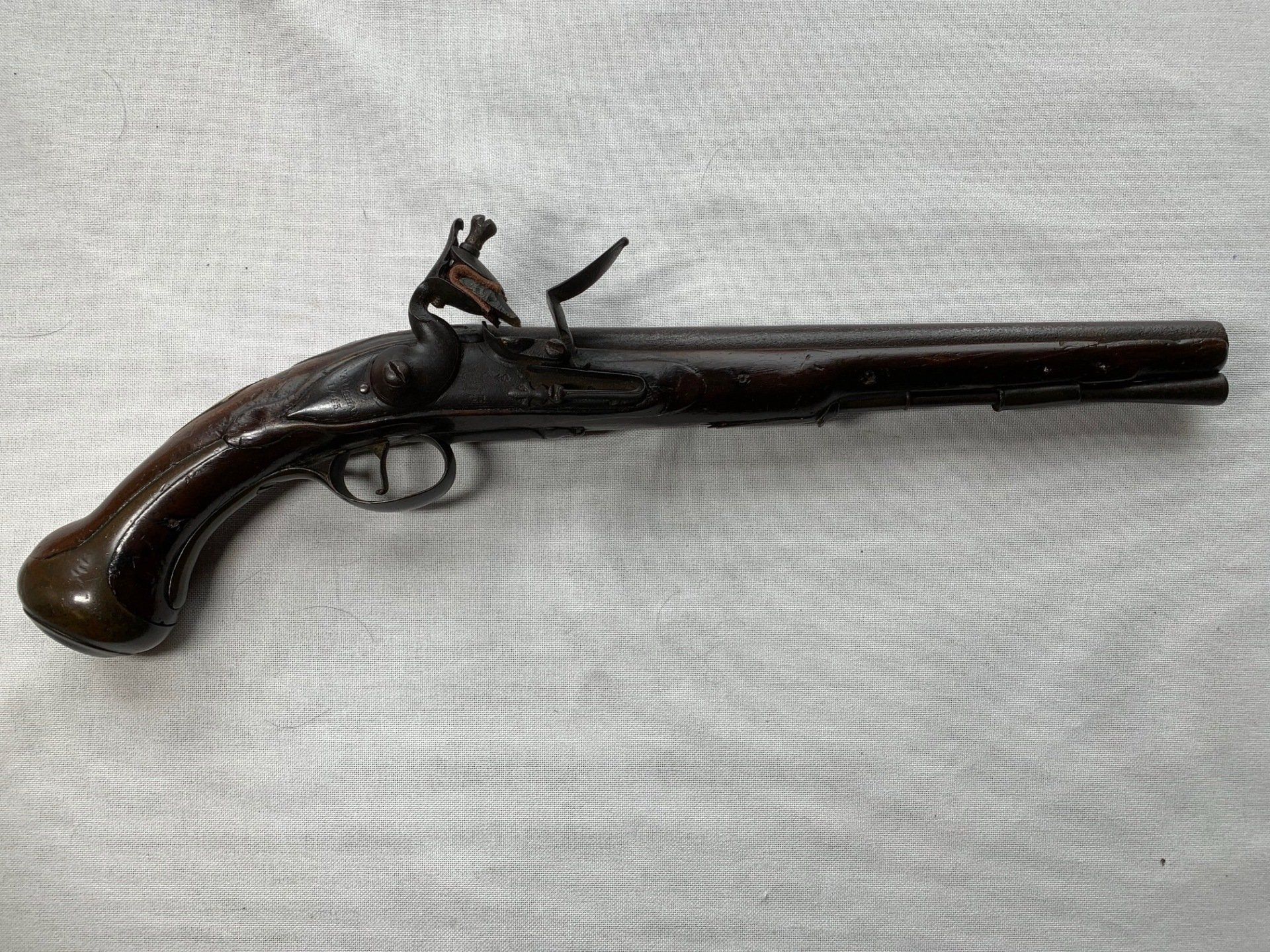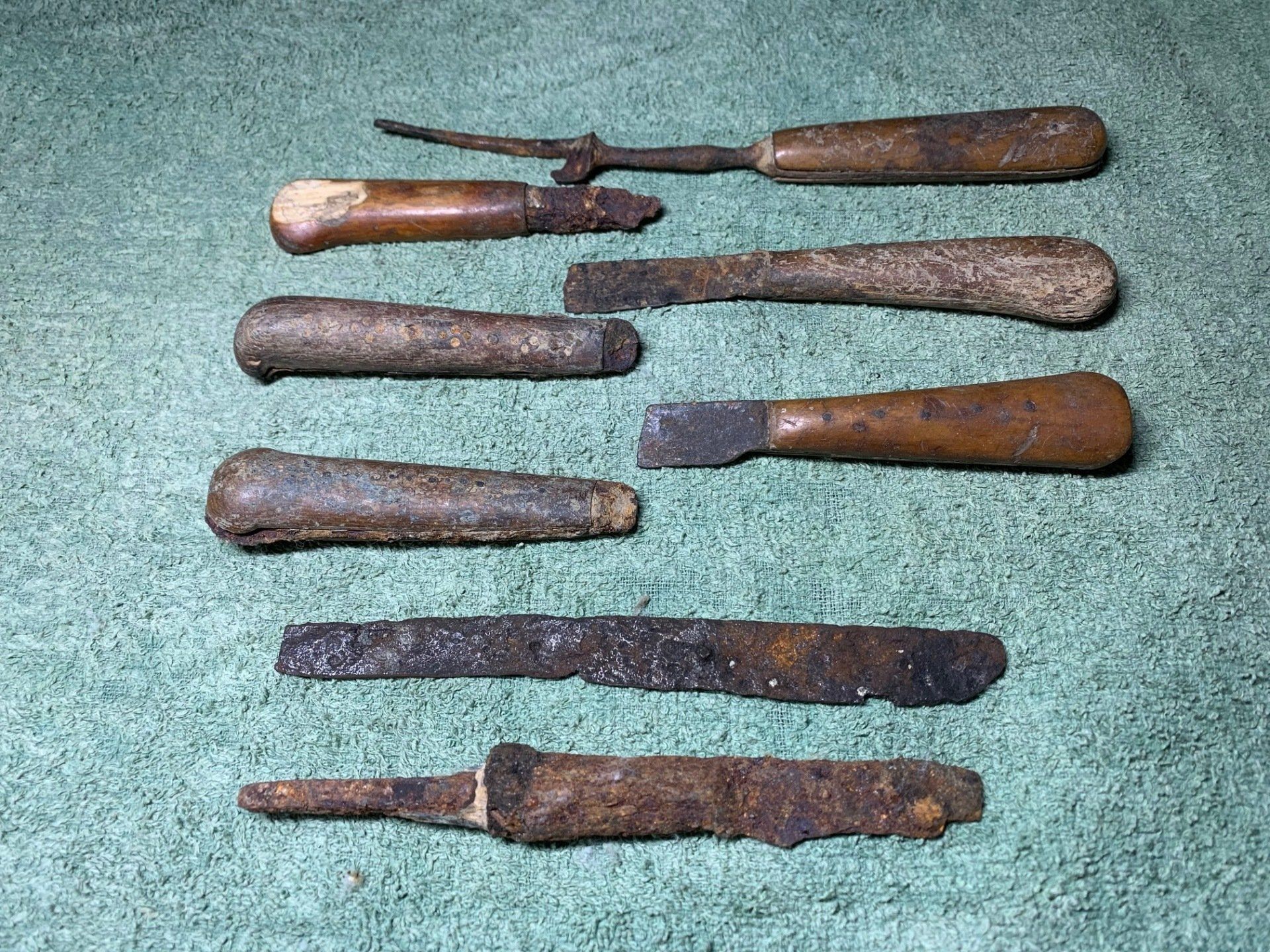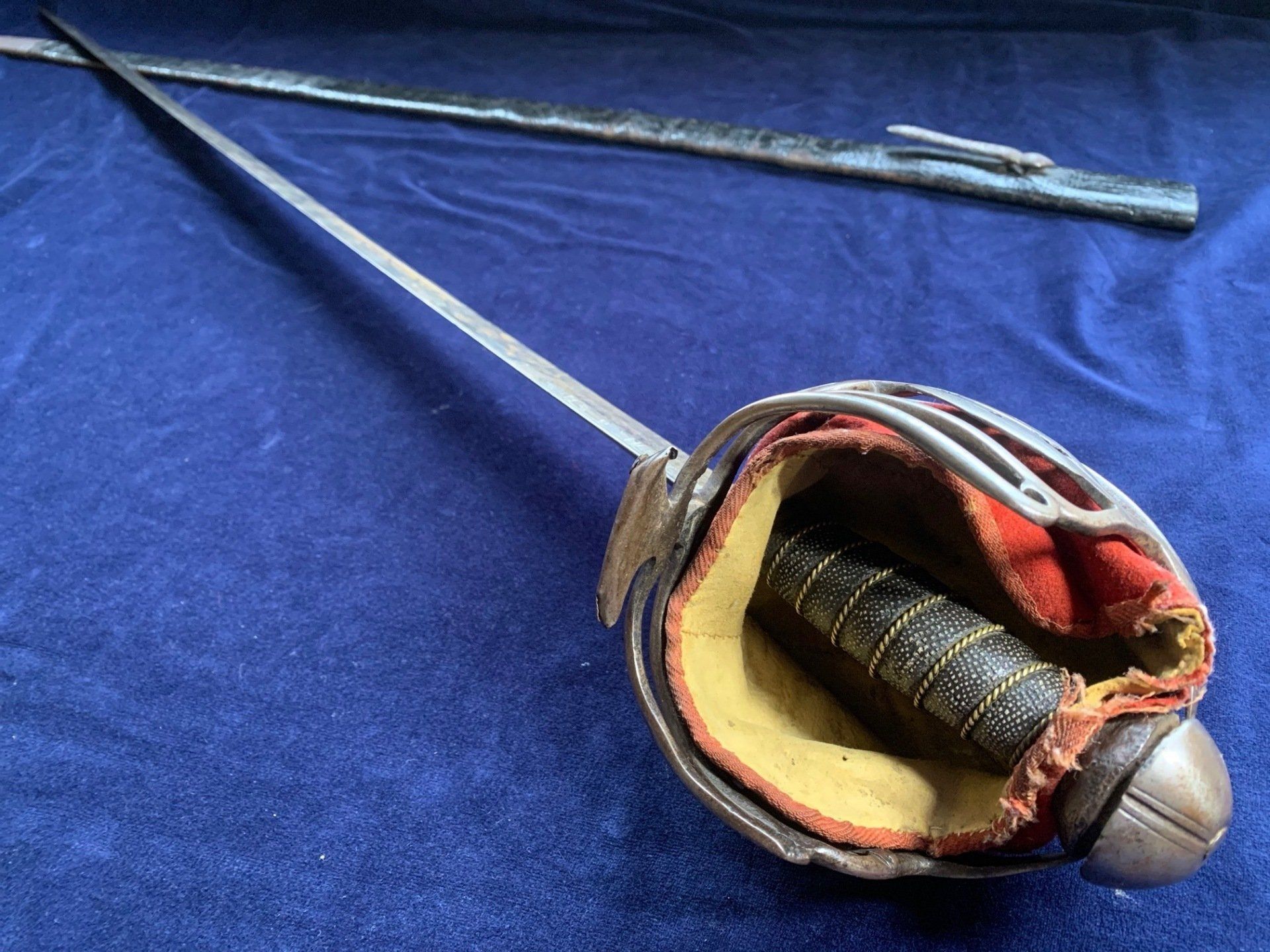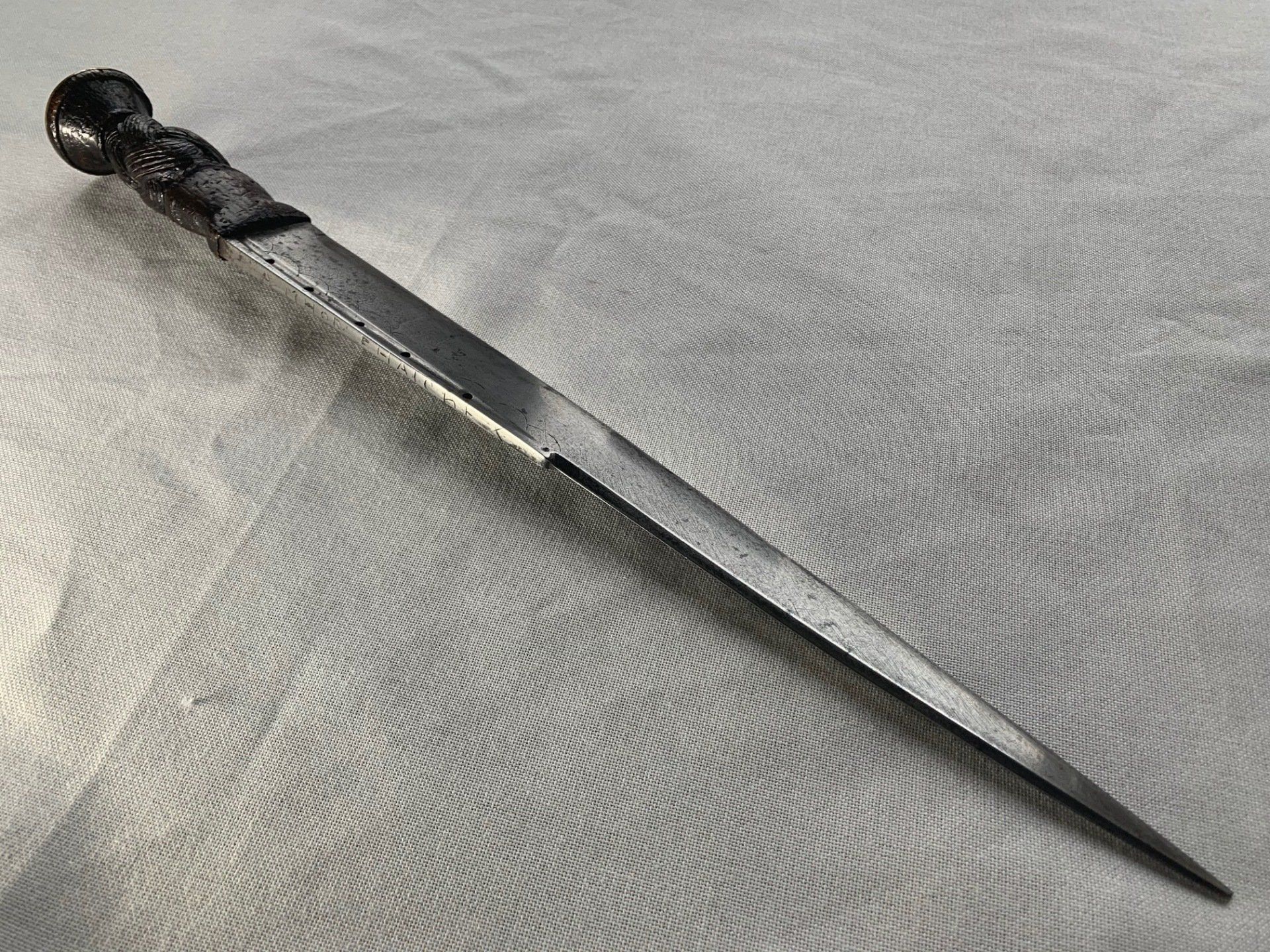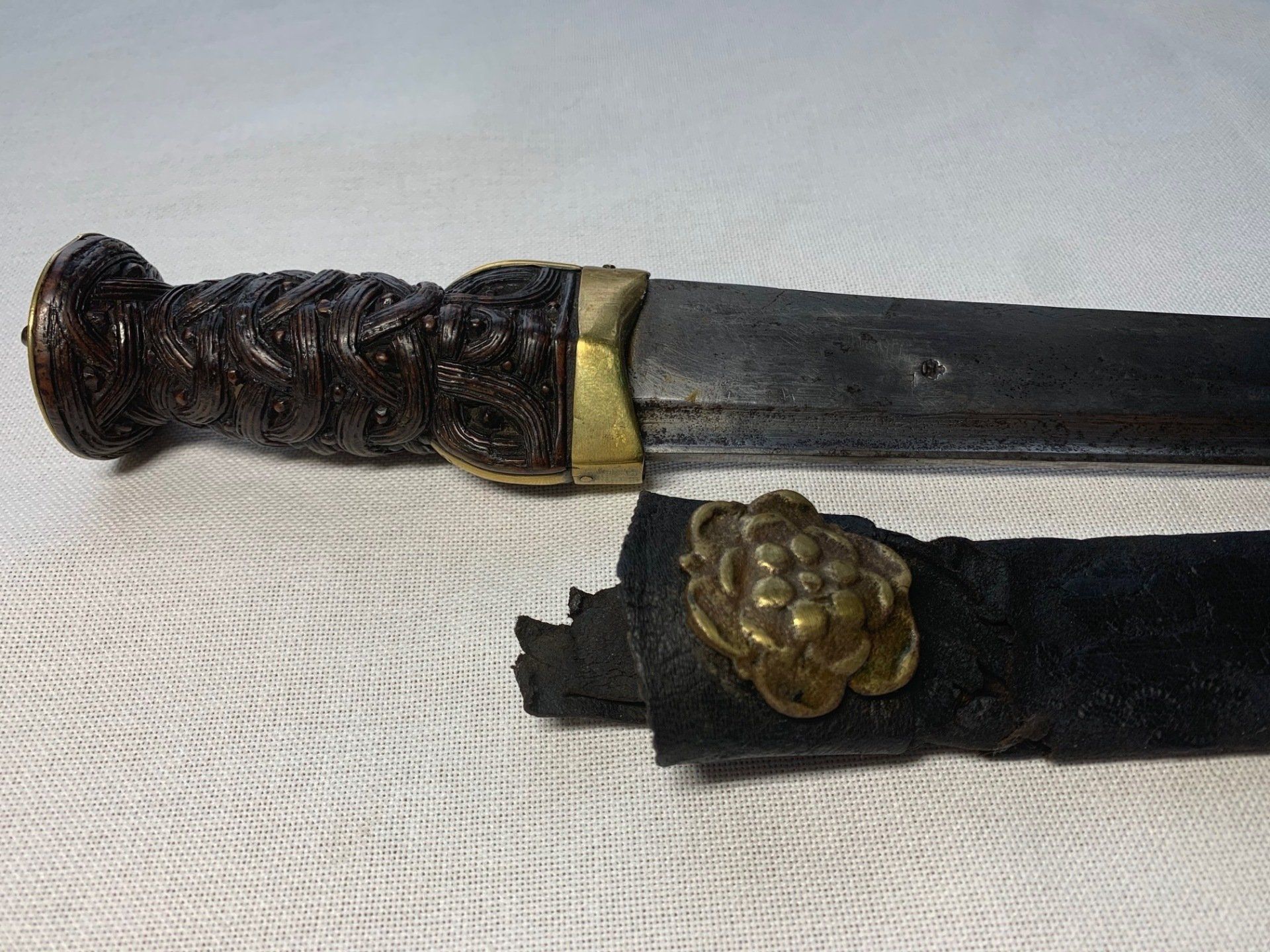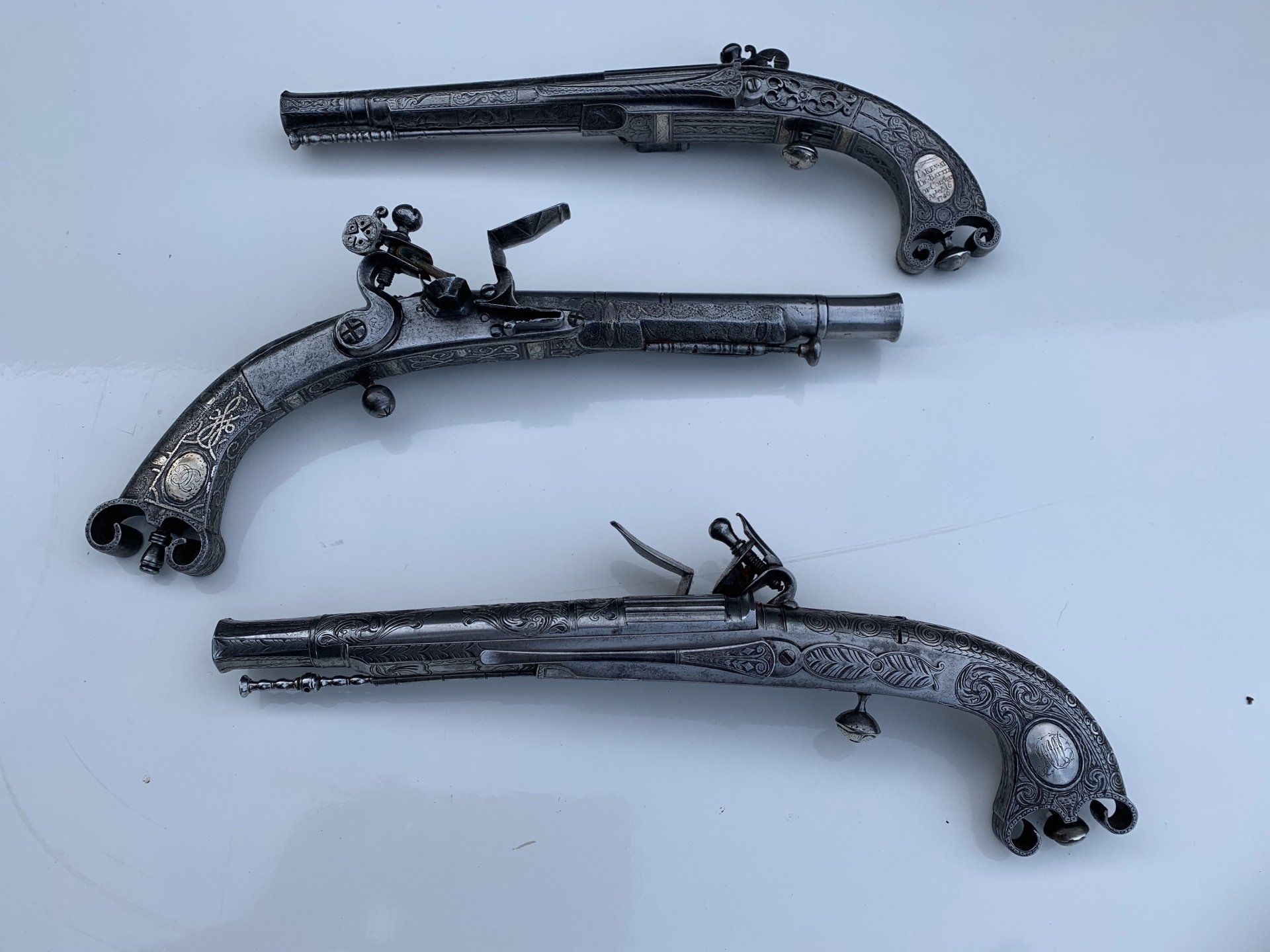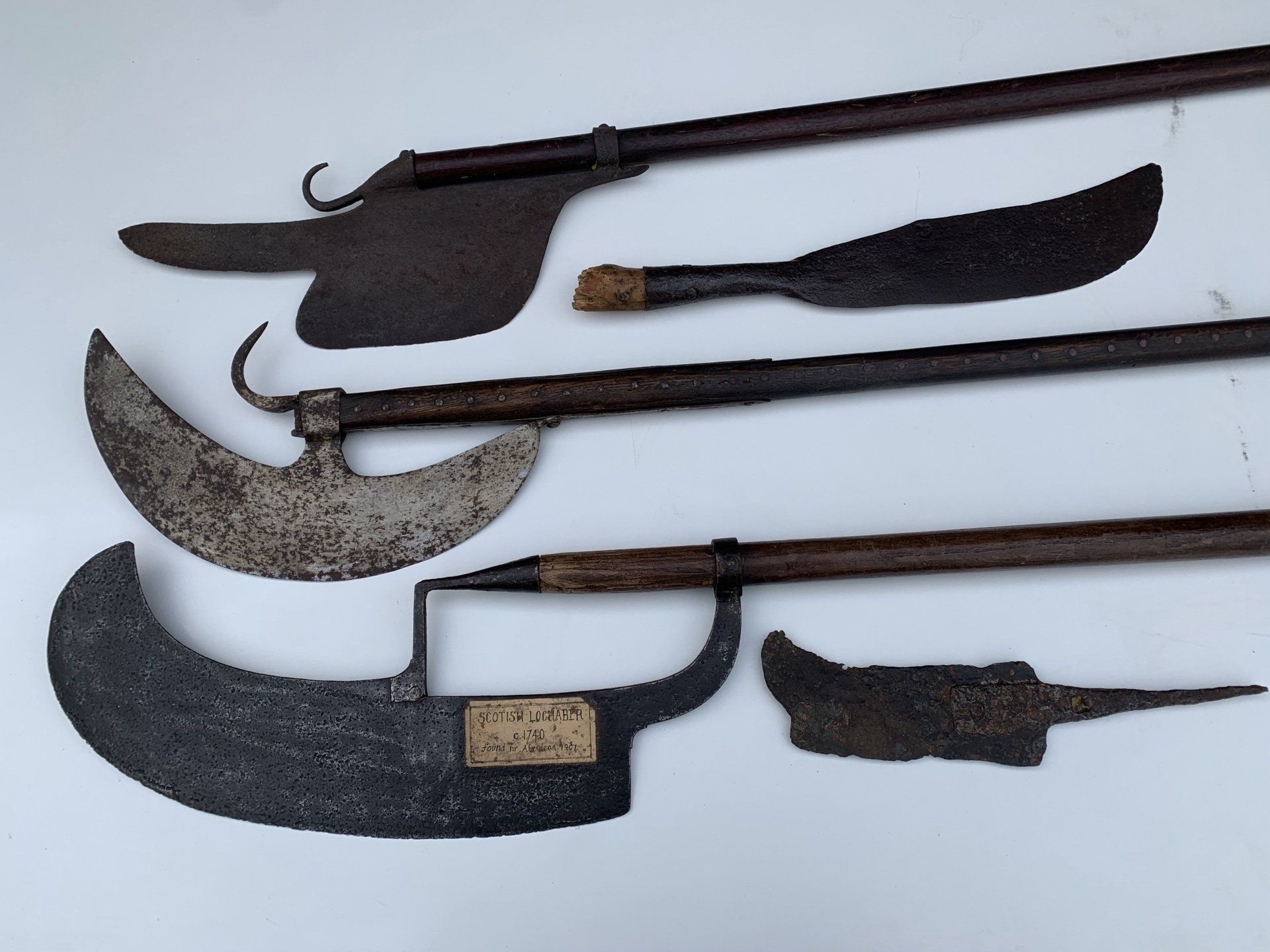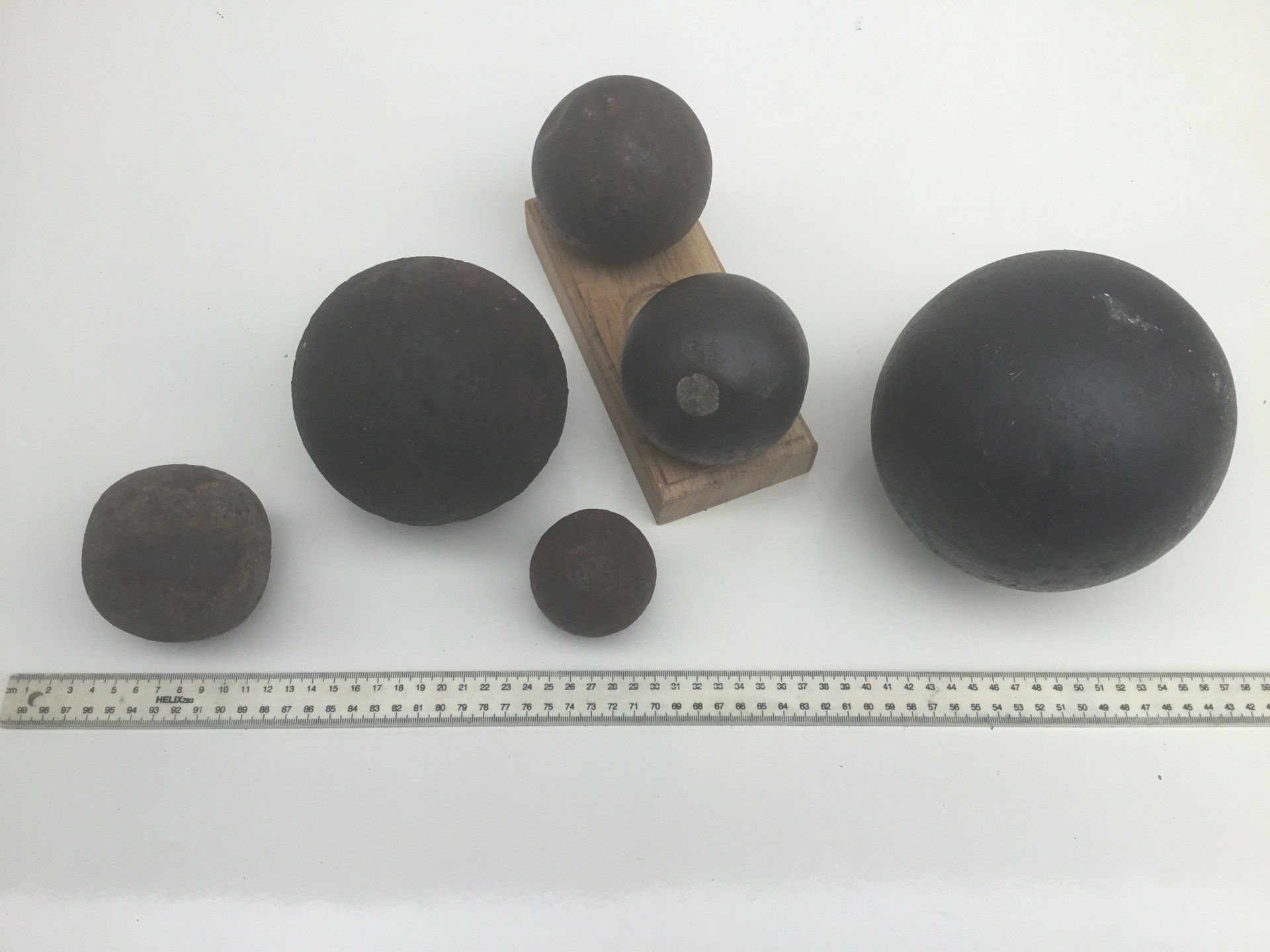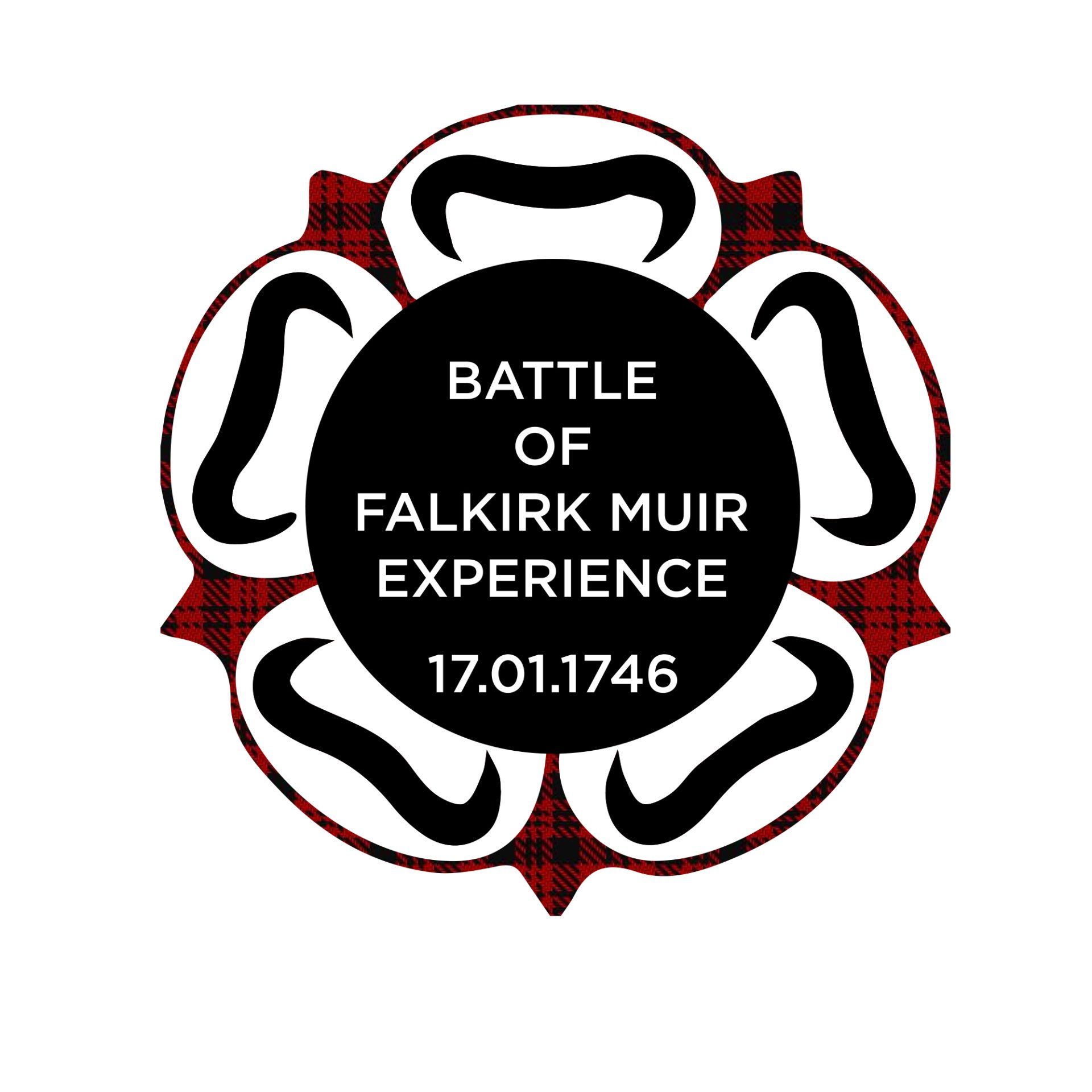Room 2 - Militaria Gallery
French Musket
This musket was a private purchase pattern made for officers only and is based on the M1728. It has CW carved into the butt.
By tradition this musket is thought to have come to Britain during the 1745 rising, possibly as part of the arms that were on the French ship 'Esperance' which was captured by the Sheerness man of war off the Dogger Bank while making for Montrose.
Added 21 September 2024
Kilravock Castle - Brown Bess barrel
This standard 0.75'' caliber iron barrel is from a Brown Bess musket. It was found in Kilravock castle grounds and is in an 'excavated' condition.
Kilravock Wood played a part in the downfall of the Jacobite night march, according to historian Christopher Duffy's book The '45.
''On the 15th, the night before the battle of Culloden, 'Soldiers were delayed as they negotiated a breach in a wall around the woodland and elements (of the Jacobite army) became lost among the trees''.
It is tempting to think this musket might have been dropped by one of these Jacobite soldiers trying to find their way through the woods in the darkness of that night before that final battle of the '45
Added 05 July 2024
Manchester Regime Mitre Cap
From the early 18th century until 1760 the British Army's Grenadier Regiments were issued with Mitre caps. The benefit of these caps compared to the conventional military caps of that time is that they don't have a brim. Cap brims hindered the action required to throw grenades.
This cap is a rare survivor from the first half of the 18th century. It is constructed from felt and wool with silver and gold thread. The symbolism on the cap is mixed. The purple felted front bears the Thistle and Rose a Lion statant, crown, flaming grenade, canons and round shot. The Hanoverian legend 'Liberty' is embroidered on the front. The rear is yellow. It has a pocket that is embroiderd with a flaming grenade surrounded by 'Manchester' together with two Regimental banners believed to be the Manchester Regiment's colours.
The Manchester Regiment was raised in November 1746 as Prince Charles' forces moved south. On their return north the following month the Regiment was left to defend Carlisle Castle. After bombardment by the Duke of Cumberland's army the Regiment surrenderred and many of the prisoners were executed.
Added 23 September 2023
James Radcliffe Court Sword
James Radcliffe, 3rd Earl of Derwentwater (London 1689-1716 London ) silver Court Sword
The Radcliffe family estates were at Dilston Castle which is located near Corbridge and it was from here that James left, in October 1715, to meet up with the Jacobite force being led by 'General' Thomas Forster MP (1683-1738).
Radcliffe, Forster and other members of the Jacobite force occupied Preston on 9th November 1715. The town came under attack by the British Army commanded by General Charles Wills. After a couple of days of street fighting the Jacobite force surrendered.
The captured Jacobite leaders were taken to London to face trial and potential execution for treason.
Forster managed to escape from Newgate prison in 1716 and made his way to Paris where he joined the Stuart Court in St Germain being appointed Steward of the Household. Radcliffe was not so fortunate. He was beheaded on Tower Hill in front of a large crowd.
This silver hilted Court sword is hallmarked 1714. The sword blade is etched with an Earl's crown, coat of arms and the legend 'Dilston Castle 1714'.
There is a traditional story that James' wife grew impatient with her husband's indecision about joining the Jacobite force and threw down her fan and challenged her husband to give her his sword. Her jibe worked as the next reference to James was of him riding through Corbridge with his sword drawn.
Added 13 March 2023
Charles Stewart of Ardsheal's Sword
Charles Stewart of Ardsheal's sword (Ardsheal 1701 - 1757 Sens, France)
Is this the sword that killed Rob Roy MacGregor?
This Broad sword has a Basket hilt made of iron and it still has it's original rayskin covered grip. The Basket was forged by Walter Allan of Stirling, one of the best Scottish makers, and dates to the second quarter of the 18th century. The blade is of high quality and might pre date the basket.
This sword, belonged to Charles James Stewart, 5th of Ardsheal who led the Appin Regiment during the '45. The regiment comprised approximately 300 men, linked up with Prince Charles Edward's army at Invergarry in August 1745. The Regiment fought in all four of the main battles of the '45 which included: Prestonpans and Clifton Moor in 1745, Falkirk Muir and Culloden in 1746. At Culloden the Regiment joined the 'Highland Charge' with the men of Atholl and the Camerons on the Jacobite right wing and were involved in the fierce hand to hand fighting with the British Army's left flank.
Although Charles Stewart of Ardsheal was described as being of very heavy build he was considered to be one of the finest swordsmen in Scotland.
Indeed this sword shows obvious signs of having been damaged during battle. The Basket has damage that has been repaired by attaching a plate to the inside of the Basket. The most likely scenario is that the sword was damage during one of the first three battles of the '45 as Charles would have had the time to get the break repaired before the next battle. The major unrepaired damage to both the sword and basket was likely caused during the fierce fighting at Culloden as it was unlikely that after the battle there would be an opportunity to get the damage repaired.
And what is the connection with the infamous Rob Roy MacGregor?
Rob Roy and Charles Stewart fought a duel with swords. According to the Dewer MSS some time during 1734 Charles Stewart and Rob Roy had a chance meeting at an inn near Balquhidder and had a disagreement about how active a part Rob Roy and his men had actually played during the '15 Rising.
At this time duels were not necessarily fights to the death but the winner was the man who drew first blood. Charles cut Rob Roy's chin so was declared the victor and was the first man to beat Rob Roy. Rob died some time later.
It is recorded that Charles Stuart had a sword he called 'the Turk' but it seems he only had this sword while he was in France. A few years ago Paul MacDonald, sword maker and Master-at-arms conserved a sword believed to be Charles Stewart's sword. Both of these swords are nearly identical. Therefore either one of the two swords was likely the one involved in this duel.
Added 23 October 2022
Robert Ross Sword Maker
This broad sword has a maker's mark 'RR' stamped inside the basket. This signifies that it was made by the Aberdonian sword maker Robert Ross who was active in the 1730 & 40s.
Robert Ross produced very few swords, but, like this very rare survivor they were of a high quality.
The blade has some letters stamped on it but it is difficult to understand their meaning.
Added 27 March 2022
Ligonier Dragoon Sword
Ligonier's Dragoons were made up of what was left of Gardiner's Dragoons.
At the start of the '45 Rising Gardiner's was given the task of observing the Jacobite army as they approached Edinburgh from the West. The plan was for the Dragoons to face the Jacobite army in order to defend the town, however, on the 17th September 1745, they thought better of that plan and they moved to the east in what has become known as the 'Coltbridge Canter'.
The Dragoons met up with General Cope and his army and gave battle to the Jacobite army on 21st September 1745 at Prestonpans.
Gardiner was mortally wounded during the battle and died a couple of days later. After his death the command of the remnants of his Dragoons was given to Francis Ligonier and they were renamed Ligonier's Dragoons. It would be expected that the horses and equipment would be transferred with the surviving men.
After being issued to Ligonier's the sword was stamped round the rein loop with the Regiment's name.
At the outset of the battle of Falkirk Muir Lieutenant General Henry Hawley sent his three Dragoon Regiments ahead of the foot to meet the Jacobite army on the hill to the south of the town of Falkirk. Many of the Dragoons were killed during thebattle, indeed, in The Roll of Honour we have listed the names of 17 members of Ligoniers that were killed during the battle
As can be seen in the image of the rein loop the Regimental name has been partially erased. Dragoon swords were longer than standard swords used by foot soldiers. Mounted soldiers require longer swords to be able to make contact with the enemy. This sword blade has been shortened to make it easier to use by someone fighting on foot.
The partial erasure of the Regiment's name and shortening of the blade would indicate that it was likely to have been taken by a Jacobite soldier after the battle of Falkirk Muir, Of course the next and final battle in the campaign was Culloden.
Perhaps this sword was used by the British army at Prestonpans and Falkirk Muir and then used by The Prince's army at Culloden.
Added 27 March 2022
'Red coat' Targe
A well equipped 18th century Highlander would carry a Targe into battle.
TheTarge was a Scottish version of a shield. It would normally be constructed with two layers of planks of wood positioned at right angles to each other. The Targe was covered in leather which was sometimes tooled. The back of the Targe might be padded with wool or straw and covered in leather. The back would have two straps fixed on it which would hold theTarge to the arm. Finally the whole Targe was held together with square cut iron nails and brass domed nails to create a design.
The Targe would normally be held onto the left arm with a Dirk in the left hand and the Sword would be held in the right hand. The Targe would protect the head and chest from sword blows and musket balls.
Targes are very rare survivors.
Tradition tells us that during the '45 men from the Jacobite army would sometimes line the back of their Targes with the material from the vanquished 'Red Coat' jackets. By so dfoing the Highlander was able to demonstrate his military prowess.
This Targe has such a piece of material on the back. We can only wonder if the jacket was removed from a corpse or a prisoner!
Added 11 January 2022
Sheriffmuir Targe
A well equipped 18th century Highlander would carry a Targe into battle.
TheTarge was a Scottish version of a shield. It would normally be constructed with two layers of planks of wood positioned at right angles to each other. The Targe was covered in leather which was sometimes tooled. The back of the Targe might be padded with wool or straw and covered in leather. The back would have two straps fixed on it which would hold theTarge to the arm. Finally the whole Targe was held together with square cut iron nails and brass domed nails to create a design.
The Targe would normally be held onto the left arm with a Dirk in the left hand and the Sword would be held in the right hand. The Targe would protect the head and chest from sword blows and musket balls.
Targes are very rare survivors.
If you look carefully at the 3 o'clock position there is 1715 hammered onto the Targe in small nails. This may indicate that the Targe was used at
Sheriffmuir.
Added 11 January 2022
Earl of Sutherland's Pistols
This brace of silver inlaid steel pistols were made in the 1740s by Alexander Campbell of Doune as evidenced by the inscription 'Alex r. Campbell Dun Fecit'
Alexander Campbell was recognised as one of the premier Scottish steel pistol makers and was based in Doune. The high quality of the manufacture of these pistols, together with the amount of silver inlay, indicates that these were very high status artefacts.
On one side of the pistol grip is engraved with the Sutherland coat of arms & clan motto topped by an Earl's crown. Given the date of manufacture the pistols will have been made for William Sutherland (Scotland 1708 - 1750 France ) the 17th Earl.
On the other side of the grip is an inscription which informs us that the pistols were subsequently gifted to Capt. Jas Sutherland in 1763. Captain James Sutherland of Langwell served in one of the two Regiments of Sutherland Fencibles that were set up the police the Highlands after the eventual failure of the '45 Rising. This Regiment was disbanded in 1763.
Although the pistols were 20 years old by the time they were gifted to Captain James Sutherland, it seemed strange that such high status pistols would be given away. However, it appears that James was an illegitimate son of the 17th Earl and had the position of Manager of Dunrobin Castle the main seat of the Earls. This explains how the pistols came back into the Castle collection.
During April 1746, Prince Charles sent the Earl of Cromartie north from Inverness to rescue the gold sent by Louis XV that had been captured by the British Army when the ship, Le Prince Charles' carrying the gold ran aground at Kyle of Tongue. On his way back Cromartie decided to pay a visit to Dunrobin Castle. No doubt Lord Elcho, who was Colonel of Elcho's Lifeguards, had asked him to check on his sister who was married to the 17th Earl of Sutherland. It is known that the 17th Earl was in the Castle when Cromartie knocked at the Castle door. As Sutherland had decided his and his clan's interests were best served by not coming out for the Stuart cause, the 17th Earl claimed he had managed to leave the Castle by the back door as Cromartie came in through the front door.
Unfortunately for Cromartie they spent too long with Lady Elizabeth and they become cut off from their main body of troops. While their Regiment was wiped out at the Battle of Littleferry fought on 15th April Cromartie was captured.
The Earl of Sutherland and his troops were present at Culloden the following day and it is extremely likely that these pistols were with the Earl of Sutherland at both Culloden and Littleferry.
Additional information researched by Colin Fraser of RL Christie works of art.
Added 20 June 2021
Landsknecht
This dagger is of a style used by German Landsknechts and it dates from the 17th century. It was found on the battlefield at Culloden.
Added 30 April 2021
Culloden Pistol
Thomas Caddell pistol taken at Culloden
Some of the best Scottish steel pistol makers in the late 17th and early 18th century were to be found in the small village of Doune. The best known makers were Caddell, Campbell, Christie and murdoch. This example is by Thomas Caddell.
The pistol is made from steel and this example is inlaid with silver. Originally the cartouche on the grip would have had the owners clan crest engraved on it. Instead this has been removed and the following inscription placed on it:
''Taken at The Battle of Culoden Apl E 16 1746''
Given that the pistol is in extremely fine condition it was not left on the battlefield for any length of time. Instead it is much more likely it was taken from a high ranking Jacobite officer by a British army officer and he had it engraved and kept it as a trophy of the battle.
Added 30 April 2021
Culloden Dagger
This dagger is very Scottish in design. It has an antler handle with a brass cap. The blade is extremely worn but it seems to have been reused from the tip of a broken sword. Many Scottish Dirks of this period also used broken sword blades but the Dirks generally have longer blades.
Added 14 April 2021
Royal Ecossais Sword
This sword was found on the Culloden battlefield at the turn of the last century by a farmer called MacDonald while ploughing his fields. He farmed the land at Hollybush Farm which is situated to the north of the NTS visitor centre. Apparently he had a shed full of blades. He exhibited some of these swords
in the Highland and Jacobite Exhibition that was held in Inverness during 1903.
Achnacarry Castle Museum has an identical sword in their collection. They say it was found on the banks of Loch Arkaig and they think it was lost by a French sailor while off loading supplies from a ship.
As this sword was found on the battlefield it is likely that the sword was used by the French Regiment The Royal Ecossais. This Regiment together with Fitzjames Horse covered the Jacobite retreat from the field of battle and undoubtedly saved many lives.
The Royal Ecossais were also present at Falkirk Muir in the previous January.
Added 14 April 2021
Culloden Lochabre Axe
This Lochabre axe was taken from Edinburgh's Town Guard during the Jacobite occupation of the Town during October 1745. It would have been carried by a Jacobite soldier all the way to Derby and back to Scotland. It would have been used at Falkirk Muir before being left on Culloden battlefield.
It was picked up after the battle and eventually it ended up in being hung up above a fireplace in Newtown flat in Edinburgh.
Added 14 April 2021
Culloden Pistol
This pistol formed part of the Shaw collection. It was sold in a sale of Important Scottish silver and pistols in 1983. The catalogue entry states that it is traditionally said to have been found on the field of Culloden.
The image indicates that the pistol must have been left on the battlefield for a significant period of time as the steel had started to deteriorate. However, the details that have been inlaid in silver look as fresh as the day the pistol was made.
Given the amount of silver inlay the pistol must have been an expensive weapon. Unfortunately the maker's name can not be made out. As was suggested with our previous posting of a Culloden pistol an X-ray might allow us to get this information.
Added 14 April 2021
Playing Cards with the Devil
This powder horn is made of cow horn with silver fittings. It bears the crest and initials of General Tam Dalyell of the Binns (Linlithgow 1615 - 1685 Canongate).
At the age of thirteen Tam went on military campaign with Charles I and after Charles' execution Tam lived in Ireland. He returned to England and commanded Charles II forces at the battle of Worcester against Oliver Cromwell's new model army in 1651. After the Royal army capitulated Tam was captured by Cromwell's forces and imprisoned in the Tower of London from which he succeeded in escaping. He subsequently took part in Glencairn's revolt in Scotland in 1654.
Unfortunately for Tam this rising failed and he fled to Russia where he commanded the Tsar's forces with distinction.
On Charles II restoration Tam returned to command an army to victory on 28th November 1666 against the Covenanters at Rullion Green in the Pentland Hills outside Edinburgh.
Tam was not involved in the second Covenanter battle of Drumclog on 1st June 1679 which the Covenanter forces won. However, he was present at the third and final battle at Bothwell Bridge three weeks later which the Royalist won.
The powder horn has these three battles inscribed on it.
Due to Tam's very poor treatment of prisoners after the Battle of Rullion Green he was nicknamed Bluidy Tam and he gained a fierce reputation. Indeed, it was thought that he played cards with the Devil.
Added 2 April 2021
British Dragoon Sword
The sword is a very fine example of a British Dragoon basket hilted back sword which is engraved with a crown, GR and Cobham on the blade. It still retains it's original liner. The basket has reign loop which allowed the dragoon to hold the horse's reigns while holding the sword.
Cobham's Dragoons fought at both Falkirk Muir and Culloden.
Added 2 April 2021
British Long Dragoon Pistol
This is an extremely fine example of an early British long Dragoon pistol. It has the date 1743, a crown and GR engraved on the lock plate and 1st No 37 engraved on the Butt. This indicates that the pistol was made for the 1st Regiment. It has the Tower test marks on the barrel.
The first Regiment formed part of the cavalry which, under the Duke of Cumberland's, were led by Lieutenant General Henry Hawley at Culloden. Previously Hawley had commanded the British Army which suffered defeat by Prince Charles' forces at Falkirk Muir in the previous January.
After the battle of Culloden Hawley's Dragoons became infamous for their brutality against the fugitive Jacobites.
Added 2 April 2021
The Knifes are Out
These remains of knives and forks were found outside Nairn where Cumberland's forces were camped the night before the battle.
It is intriguing to think that the men who last used these knives and forks were celebrating the Duke of Cumberland's 25th birthday as the Jacobite forces were marching on them to try a surprise attack. A night march that almost succeeded but perhaps went some way to loosing them the battle the following day due to the fatigue of their forces.
These remains of knives and forks were found outside Nairn where Cumberland's forces were camped the night before the battle.
It is intriguing to think that the men who last used these knives and forks were celebrating the Duke of Cumberland's 25th birthday as the Jacobite forces were marching on them to try a surprise attack. A night march that almost succeeded but perhaps went some way to loosing them the battle the following day due to the fatigue of their forces.
Added 2 April 2021
Artefacts from Culloden
THIS image shows some battle debris that was left behind after the battle was finished. The buttons, badges and buckles support the belief that there was fierce hand to hand fighting resulting in these it personal items being ripped from the combatants clothes.
The lead circular item at the top of the image is a gunpowder measure with two flints next to it. The item below the Rams head badge is unusual. It seems to be made of brass or copper and shows signs of burning inside.
On the left there is the remains of a steel pistol. The silver item next to it is also unusual, the top is designed as a crown with roses and thistles round the edge.
These items were all found in the early 1980s apparently to the north of the current B9006 which is an area outwith the land owned by the NTS.
Added 2 April 2021
Artefacts from Culloden
This image shows two canon balls on the right and a Naval grapeshot on the left.
The canon balls measure 3 1/2 inches in diameter and weigh six pounds. The canon ball at the bottom of the image has a deep impact mark which indicates that it has been fired. It is known that the British army only had three pounders on the battlefield therefore these must have been Jacobite shot.
The smaller ball is Naval Grapeshot. It will have been supplied to the British Army by one of the Royal Navy vessels that were stationed in the Moray Firth.
These items were all found in the early 1980s apparently to the north of the current B9006 which is an area outwith the land owned by the NTS.
Added 2 April 2021
Lord Forbes of Pitsligo Sword
This 'Jacobite' sword and tooled leather scabbard was owned by Alexander Forbes, Lord Forbes of Pitsligo (1678-1762).
The broadsword blade has Jacobite mottos etched and gilded on both sides. One side states ' For God my Country & James the 8th' the other side has ' Prosperity to Schotland and no union.
Given the reference to the union of the crowns of 1707 this must date the sword to a period round about this time and the message to support James the 8th indicates the sword was produced for the Scottish market. The blades are most likely German and a quantity were commissioned by king James VIII and were sent to Scotland where Scottish craftsmen produced and fitted the baskets. They were given by the King as gifts to leading Jacobites.
This example was owned and used by Lord Forbes of Pitsligo who fought at Sheriffmuir and who raised a regiment of cavalry called Pitsligo Horse which joined up with Prince Charles Edward Stuart's forces in Edinburgh on 8th October 1745 just after Charles' victory at Prestonpans.
Despite his advanced age Lord Forbes of Pitslgo marched into England with the Jacobite forces, indeed Pitsligo Horse were among the first of the army to enter Manchester on 28th November 1745.On his arrival in the town Lord Forbes of Pitsligo sent for the town Constable, a man called Fowden, to come before him to take orders.
Constable Fowden 'demanded by what authority he was sent for'. Pitsligo drew this sword and said 'Damn you - by this'.
On the army's return to Scotland Pitsligo Horse fought at both the Battle of Falkirk Muir and Culloden.
Like many of the defeated Jacobites Pitsligo went on the run from the British army and lived out most of his remaining years in a cave near to his castle at Rosehearty.
Added 2 April 2021
Sir Simon Fraser, Lord Lovat's Dirk
This 17th century Scottish Dirk has the Gaelic inscription 'A Mhor Fhaiche', The Great Field, on the back edge. This was the ancient Fraser of Lovat battle cry until about 1671 at which time Lovat Castle was dismantled and the clan seat was moved to Dounie Castle at which time the battle cry was changed to 'Caisteal Dhuni'. The Great Field referred to was the field next to Lovat Castle where the clan warriors would assemble before a battle.
The story of this Dirk is that it was owned by Alexander Fraser, the elder brother of Simon. During a banquet at Beauly, soon after the Battle of Killiecrankie in 1689, Alexander took offence at a satirical song being played by a Piper. Alexander went to burst the pipes with this Dirk but in the ensuing scuffle mortally wounded the Piper. Alexander then fled to Wales and disappeared resulting in Simon becoming heir apparent.
Simon, nicknamed 'The Fox,' supported the British Government during the '15. However, as portrayed in Outlander, he changed sides during the '45 and raised the clan Fraser to support Prince Charles. This decision proved fateful for Simon as he was captured after the Jacobite defeat at Culloden and was executed on Tower Hill on 9th April 1747.
Added 18 March 2021
A Scottish Dirk
This Dirk started life as a British Army sword.
As the image shows there is a royal crown stamped on both sides of the blade. There would have also have been initials 'GR', for George Rex, stamped below the crown. These letters have been erased by removing part of the surface and this indent can be still be seen on the blade.
Scottish Dirk blades were either specially made or, alternatively, they were made from broken sword blades which were collected after a battle. Given that this blade originally had a crown and GR stamped on it the indications are that this blade is from a British Army sword. The handle is carved in ancient bog oak with a traditional Celtic design. The leather scabbard which allowed it to be attached to a belt is a rare surviver. It has a large brass Jacobite rose attached to it.
Given the removal of the GR and the attachment of the Jacobite rose there is little doubt that this Dirk was a proud possession of a Jacobite soldier.
The two main possibilities are that it was used by Cope's Army at the Battle of Prestonpans and then picked up by a Jacobite after the battle and then used at Falkirk Muir and Culloden or it was used by the Hawley's Army at Falkirk Muir and picked up by a Jacobite and used at Culloden.
Whatever the truth there is little doubt that if the Dirk could talk it would have some stories to tell.
Added 8 March 2021
Scottish Pistols
Whilst Doune produced the best quality and most expensive Scottish steel pistols other towns were involved in their production.
From top to bottom:
'A traitors pistol' this pistol was made by John Campbell of Doune and bears the crest of Sir Alexander Macdonald of Sleat who refused to raise his clan for Prince Charles in 1745.
This pistol was produced in Stirling in the early 18th century.
This pistol was made by Thomas Caddell another well known Doune pistol maker. The origianal owners crest was removed in 1746 and replaced with the following inscription ' taken at the battle of Culloden April 16th 1746' As it is inlaid with silver it must have been originally owned by a wealthy clan chief before becoming a trophy from the battle.
Added 7 November 2020
Muskets
The top musket is known as a doglock and is engraved with James II royal cypher. It therefore dates to 1685 to 1689 and would have been the type of weapon used during the first rising that included the battles of St Johnstone, Killiecrankie, Dunkeld and Cromdale.
The bottom musket is a 'Brown Bess'. It has George II crown and cypher and is dated 1743. It is the type of weapon used by the redcoats in the final rising that included the battles of Prestonpans, Cliftom Moor, Falkirk Muir and Culloden Moor.
Narrative updated 4 December 2020
Lochabre Axe
Along with the Scottish Broadsword, Dirk and Targe the Lochabre axe was another iconic weapon used by the Jacobites. It was based on the agricultural implements of their time.
These Lochabre axes all date from the 18th century. The blade with the broken shaft second from the top was taken by the Jacobites from the Edinburgh Town Guard during their occupation of the town in October 1745. It was subsequently taken as a trophy from Culloden battlefield after the battle ended.
The bottom blade was used at the battle of Sheriffmuir in 1715.
Added 7 November 2020
Falkirk Weapons
For the first time in almost 270 years these weapons, that were all used during the battle of Falkirk Muir, have been brought together.
The four swords on the left and the four dirks were carried by Jacobites. The pistol, bayonet and the three swords on the right were carried by members of the British army.
If you want more information about any weapons just get in touch!
Added 27 September 2020
Cannon Balls
This collection of cannon balls include from left to right:
- A cannon ball fired during The Duke of Cumberland's siege of Carlisle Castle.
- A cannon ball excavated in Inverness near the site of the 'old' Fort George where the present day Inverness Castle stands. The old Fort was captured and subsequently blown up by the Jacobite forces during February 1746.
- A cannon ball found on Culloden Moor
- Two cannon balls of identical size and weight found on Culloden Moor. The furthest away shot has been fired.
- A cannon ball from the 'new' Fort George
Added 16 August 2020

